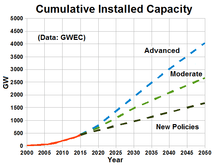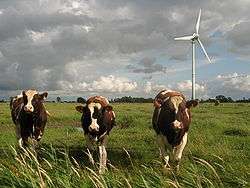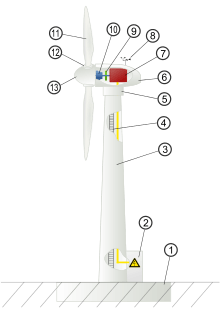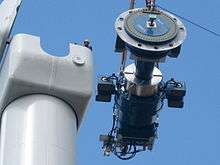Wind power
Wind power or wind energy is the use of wind to provide the mechanical power through wind turbines to turn electric generators and traditionally to do other work, like milling or pumping. Wind power is a sustainable and renewable energy, and has a much smaller impact on the environment compared to burning fossil fuels.
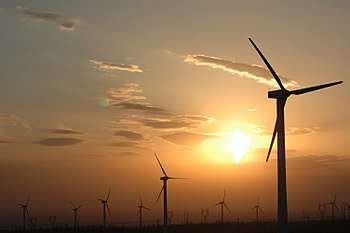
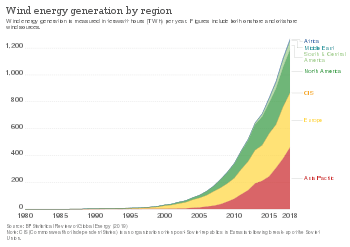
| Part of a series about |
| Sustainable energy |
|---|
 |
| Overview |
| Energy conservation |
| Renewable energy |
| Sustainable transport |
|
Wind farms consist of many individual wind turbines, which are connected to the electric power transmission network. Onshore wind is an inexpensive source of electric power, competitive with or in many places cheaper than coal or gas plants.[2][3][4][5] Onshore wind farms also have an impact on the landscape, as typically they need to be spread over more land than other power stations[6][7] and need to be built in wild and rural areas, which can lead to "industrialization of the countryside"[8] and habitat loss.[7] Offshore wind is steadier and stronger than on land and offshore farms have less visual impact, but construction and maintenance costs are higher. Small onshore wind farms can feed some energy into the grid or provide electric power to isolated off-grid locations.[9]
The wind is an intermittent energy source, which cannot make electricity nor be dispatched on demand.[6] It also gives variable power, which is consistent from year to year but varies greatly over shorter time scales. Therefore, it must be used together with other electric power sources or storage to give a reliable supply. As the proportion of wind power in a region increases, more conventional power sources are needed to back it up (such as fossil fuel power and nuclear power), and the grid may need to be upgraded.[10][11] Power-management techniques such as having dispatchable power sources, enough hydroelectric power, excess capacity, geographically distributed turbines, exporting and importing power to neighboring areas, energy storage, or reducing demand when wind production is low, can in many cases overcome these problems.[12][13] Weather forecasting permits the electric-power network to be readied for the predictable variations in production that occur.[14][15][16]
In 2018, wind supplied 4.8% of worldwide electricity,[17] with the global installed wind power capacity reaching 591 GW.[18] Wind power supplied 15% of the electricity consumed in Europe in 2019.[19] At least 83 other countries are using wind power to supply their electric power grids.[20]
History
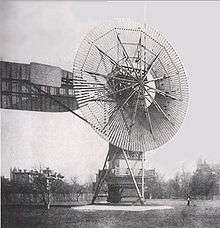
Wind power has been used as long as humans have put sails into the wind. King Hammurabi's Codex (reign 1792 - 1750 BC) already mentioned windmills for generating mechanical energy.[22] Wind-powered machines used to grind grain and pump water, the windmill and wind pump, were developed in what is now Iran, Afghanistan and Pakistan by the 9th century.[23][24] Wind power was widely available and not confined to the banks of fast-flowing streams, or later, requiring sources of fuel. Wind-powered pumps drained the polders of the Netherlands, and in arid regions such as the American mid-west or the Australian outback, wind pumps provided water for livestock and steam engines.
The first windmill used for the production of electric power was built in Scotland in July 1887 by Prof James Blyth of Anderson's College, Glasgow (the precursor of Strathclyde University).[25] Blyth's 10 metres (33 ft) high, the cloth-sailed wind turbine was installed in the garden of his holiday cottage at Marykirk in Kincardineshire and was used to charge accumulators developed by the Frenchman Camille Alphonse Faure, to power the lighting in the cottage,[25] thus making it the first house in the world to have its electric power supplied by wind power.[26] Blyth offered the surplus electric power to the people of Marykirk for lighting the main street, however, they turned down the offer as they thought electric power was "the work of the devil."[25] Although he later built a wind turbine to supply emergency power to the local Lunatic Asylum, Infirmary and Dispensary of Montrose, the invention never really caught on as the technology was not considered to be economically viable.[25]
Across the Atlantic, in Cleveland, Ohio, a larger and heavily engineered machine was designed and constructed in the winter of 1887–1888 by Charles F. Brush.[27] This was built by his engineering company at his home and operated from 1886 until 1900.[28] The Brush wind turbine had a rotor 17 metres (56 ft) in diameter and was mounted on an 18 metres (59 ft) tower. Although large by today's standards, the machine was only rated at 12 kW. The connected dynamo was used either to charge a bank of batteries or to operate up to 100 incandescent light bulbs, three arc lamps, and various motors in Brush's laboratory.[29]
With the development of electric power, wind power found new applications in lighting buildings remote from centrally-generated power. Throughout the 20th century parallel paths developed small wind stations suitable for farms or residences. The 1973 oil crisis triggered the investigation in Denmark and the United States that led to larger utility-scale wind generators that could be connected to electric power grids for remote use of power. By 2008, the U.S. installed capacity had reached 25.4 gigawatts, and by 2012 the installed capacity was 60 gigawatts.[30] Today, wind-powered generators operate in every size range between tiny stations for battery charging at isolated residences, up to near-gigawatt sized offshore wind farms that provide electric power to national electrical networks.
Wind energy
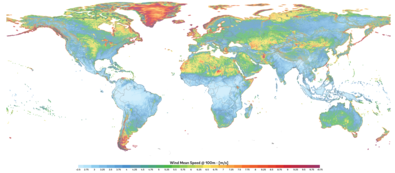

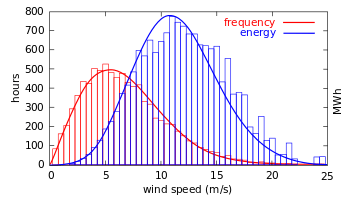
Wind energy is the kinetic energy of air in motion, also called wind. Total wind energy flowing through an imaginary surface with area A during the time t is:
where ρ is the density of air; v is the wind speed; Avt is the volume of air passing through A (which is considered perpendicular to the direction of the wind); Avtρ is therefore the mass m passing through "A". ½ ρv2 is the kinetic energy of the moving air per unit volume.
Power is energy per unit time, so the wind power incident on A (e.g. equal to the rotor area of a wind turbine) is:
Wind power in an open air stream is thus proportional to the third power of the wind speed; the available power increases eightfold when the wind speed doubles. Wind turbines for grid electric power, therefore, need to be especially efficient at greater wind speeds.
Wind is the movement of air across the surface of the Earth, affected by areas of high pressure and of low pressure.[33] The global wind kinetic energy averaged approximately 1.50 MJ/m2 over the period from 1979 to 2010, 1.31 MJ/m2 in the Northern Hemisphere with 1.70 MJ/m2 in the Southern Hemisphere. The atmosphere acts as a thermal engine, absorbing heat at higher temperatures, releasing heat at lower temperatures. The process is responsible for production of wind kinetic energy at a rate of 2.46 W/m2 sustaining thus the circulation of the atmosphere against frictional dissipation.[34]
Through wind resource assessment it is possible to provide estimates of wind power potential globally, by country or region, or for a specific site. A global assessment of wind power potential is available via the Global Wind Atlas provided by the Technical University of Denmark in partnership with the World Bank.[31][35][36] Unlike 'static' wind resource atlases which average estimates of wind speed and power density across multiple years, tools such as Renewables.ninja provide time-varying simulations of wind speed and power output from different wind turbine models at an hourly resolution.[37] More detailed, site-specific assessments of wind resource potential can be obtained from specialist commercial providers, and many of the larger wind developers will maintain in-house modeling capabilities.
The total amount of economically extractable power available from the wind is considerably more than present human power use from all sources.[38] Axel Kleidon of the Max Planck Institute in Germany, carried out a "top-down" calculation on how much wind energy there is, starting with the incoming solar radiation that drives the winds by creating temperature differences in the atmosphere. He concluded that somewhere between 18 TW and 68 TW could be extracted.[39]
Cristina Archer and Mark Z. Jacobson presented a "bottom-up" estimate, which unlike Kleidon's are based on actual measurements of wind speeds, and found that there is 1700 TW of wind power at an altitude of 100 metres (330 ft) over land and sea. Of this, "between 72 and 170 TW could be extracted in a practical and cost-competitive manner".[39] They later estimated 80 TW.[40] However research at Harvard University estimates 1 watt/m2 on average and 2–10 MW/km2 capacity for large scale wind farms, suggesting that these estimates of total global wind resources are too high by a factor of about 4.[41]
The strength of wind varies, and an average value for a given location does not alone indicate the amount of energy a wind turbine could produce there.
To assess prospective wind power sites a probability distribution function is often fit to the observed wind speed data.[42] Different locations will have different wind speed distributions. The Weibull model closely mirrors the actual distribution of hourly/ten-minute wind speeds at many locations. The Weibull factor is often close to 2 and therefore a Rayleigh distribution can be used as a less accurate, but simpler model.[43]
Wind farms
| Wind farm | Capacity (MW) |
Country | Refs |
|---|---|---|---|
| Gansu Wind Farm | 7,965 | [44][45] | |
| Muppandal wind farm | 1,500 | [46] | |
| Alta (Oak Creek-Mojave) | 1,320 | [47] | |
| Jaisalmer Wind Park | 1,064 | [48] | |
| Shepherds Flat Wind Farm | 845 | [49] | |
| Roscoe Wind Farm | 782 | ||
| Horse Hollow Wind Energy Center | 736 | [50][51] | |
| Capricorn Ridge Wind Farm | 662 | [50][51] | |
| Fântânele-Cogealac Wind Farm | 600 | [52] | |
| Fowler Ridge Wind Farm | 600 | [53] | |
| Whitelee Wind Farm | 539 | [54] |
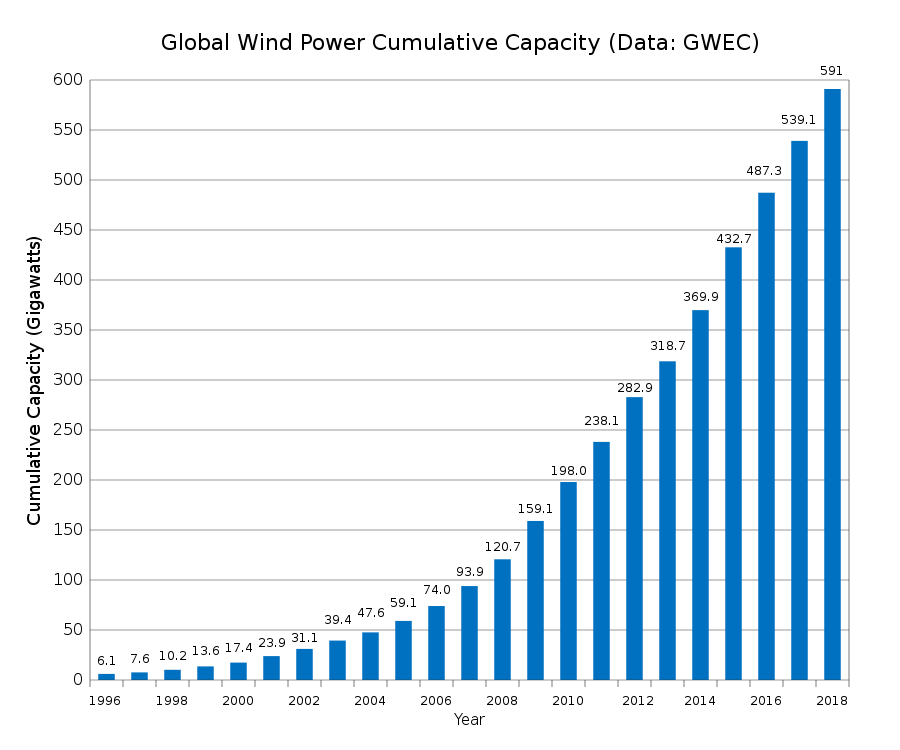
A wind farm is a group of wind turbines in the same location used for the production of electric power. A large wind farm may consist of several hundred individual wind turbines distributed over an extended area, but the land between the turbines may be used for agricultural or other purposes. For example, Gansu Wind Farm, the largest wind farm in the world, has several thousand turbines. A wind farm may also be located offshore.
Almost all large wind turbines have the same design — a horizontal axis wind turbine having an upwind rotor with 3 blades, attached to a nacelle on top of a tall tubular tower.
In a wind farm, individual turbines are interconnected with a medium voltage (often 34.5 kV) power collection system[56] and communications network. In general, a distance of 7D (7 times the rotor diameter of the wind turbine) is set between each turbine in a fully developed wind farm.[57] At a substation, this medium voltage electric current is increased in voltage with a transformer for connection to the high voltage electric power transmission system.[58]
Generator characteristics and stability
Induction generators, which were often used for wind power projects in the 1980s and 1990s, require reactive power for excitation, so electrical substations used in wind-power collection systems include substantial capacitor banks for power factor correction. Different types of wind turbine generators behave differently during transmission grid disturbances, so extensive modeling of the dynamic electromechanical characteristics of a new wind farm is required by transmission system operators to ensure predictable stable behavior during system faults (see wind energy software). In particular, induction generators cannot support the system voltage during faults, unlike steam or hydro turbine-driven synchronous generators.
Induction generators aren't used in current turbines. Instead, most turbines use variable speed generators combined with partial- or full-scale power converter between the turbine generator and the collector system, which generally have more desirable properties for grid interconnection and have Low voltage ride through-capabilities.[59] Modern concepts use either doubly fed electric machines with partial-scale converters or squirrel-cage induction generators or synchronous generators (both permanently and electrically excited) with full scale converters.[60]
Transmission systems operators will supply a wind farm developer with a grid code to specify the requirements for interconnection to the transmission grid. This will include power factor, constancy of frequency and dynamic behaviour of the wind farm turbines during a system fault.[61][62]
Offshore wind power
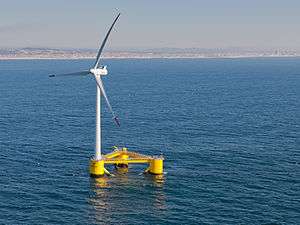
Offshore wind power refers to the construction of wind farms in large bodies of water to generate electric power. These installations can utilize the more frequent and powerful winds that are available in these locations and have less aesthetic impact on the landscape than land based projects. However, the construction and the maintenance costs are considerably higher.[63][64]
Siemens and Vestas are the leading turbine suppliers for offshore wind power. Ørsted, Vattenfall and E.ON are the leading offshore operators.[65] As of October 2010, 3.16 GW of offshore wind power capacity was operational, mainly in Northern Europe. Offshore wind power capacity is expected to reach a total of 75 GW worldwide by 2020, with significant contributions from China and the US.[65] The UK's investments in offshore wind power have resulted in a rapid decrease of the usage of coal as an energy source between 2012 and 2017, as well as a drop in the usage of natural gas as an energy source in 2017.[66]
In 2012, 1,662 turbines at 55 offshore wind farms in 10 European countries produced 18 TWh, enough to power almost five million households.[67] As of September 2018 the Walney Extension in the United Kingdom is the largest offshore wind farm in the world at 659 MW.[68]
| Wind farm | Capacity (MW) | Country | Turbines and model | Commissioned | Refs |
|---|---|---|---|---|---|
| Walney Extension | 659 | 47 x Vestas 8MW 40 x Siemens Gamesa 7MW | 2018 | [68] | |
| London Array | 630 | 175 × Siemens SWT-3.6 | 2012 | [69][70][71] | |
| Gemini Wind Farm | 600 | 150 × Siemens SWT-4.0 | 2017 | [72] | |
| Gwynt y Môr | 576 | 160 × Siemens SWT-3.6 107 | 2015 | [73] | |
| Greater Gabbard | 504 | 140 × Siemens SWT-3.6 | 2012 | [74] | |
| Anholt | 400 | 111 × Siemens SWT-3.6–120 | 2013 | [75] | |
| BARD Offshore 1 | 400 | 80 BARD 5.0 turbines | 2013 | [76] |
Collection and transmission network
In a wind farm, individual turbines are interconnected with a medium voltage (usually 34.5 kV) power collection system and communications network. At a substation, this medium-voltage electric current is increased in voltage with a transformer for connection to the high voltage electric power transmission system.
A transmission line is required to bring the generated power to (often remote) markets. For an offshore station, this may require a submarine cable. Construction of a new high voltage line may be too costly for the wind resource alone, but wind sites may take advantage of lines installed for conventionally fueled generation.
One of the biggest current challenges to wind power grid integration in the United States is the necessity of developing new transmission lines to carry power from wind farms, usually in remote lowly populated states in the middle of the country due to availability of wind, to high load locations, usually on the coasts where population density is higher. The current transmission lines in remote locations were not designed for the transport of large amounts of energy.[77] As transmission lines become longer the losses associated with power transmission increase, as modes of losses at lower lengths are exacerbated and new modes of losses are no longer negligible as the length is increased, making it harder to transport large loads over large distances.[78] However, resistance from state and local governments makes it difficult to construct new transmission lines. Multi-state power transmission projects are discouraged by states with cheap electric power rates for fear that exporting their cheap power will lead to increased rates. A 2005 energy law gave the Energy Department authority to approve transmission projects states refused to act on, but after an attempt to use this authority, the Senate declared the department was being overly aggressive in doing so.[77] Another problem is that wind companies find out after the fact that the transmission capacity of a new farm is below the generation capacity, largely because federal utility rules to encourage renewable energy installation allow feeder lines to meet only minimum standards. These are important issues that need to be solved, as when the transmission capacity does not meet the generation capacity, wind farms are forced to produce below their full potential or stop running altogether, in a process known as curtailment. While this leads to potential renewable generation left untapped, it prevents possible grid overload or risk to reliable service.[79]
Wind power capacity and production

In 2015 there were over 200,000 wind turbines operating, with a total nameplate capacity of 432 GW worldwide.[80] The European Union passed 100 GW nameplate capacity in September 2012,[81] while the United States surpassed 75 GW in 2015 and China's grid connected capacity passed 145 GW in 2015.[80] In 2015 wind power constituted 15.6% of all installed power generation capacity in the European Union and it generated around 11.4% of its power.[82]
World wind generation capacity more than quadrupled between 2000 and 2006, doubling about every 3 years. The United States pioneered wind farms and led the world in installed capacity in the 1980s and into the 1990s. In 1997 installed capacity in Germany surpassed the United States and led until once again overtaken by the United States in 2008. China has been rapidly expanding its wind installations in the late 2000s and passed the United States in 2010 to become the world leader. As of 2011, 83 countries around the world were using wind power on a commercial basis.[20]
The actual amount of electric power that wind can generate is calculated by multiplying the nameplate capacity by the capacity factor, which varies according to equipment and location. Estimates of the capacity factors for wind installations are in the range of 35% to 44%.[83]
|
Top 10 countries by cumulative wind capacity in 2019[84]
|
Number of countries with wind capacities in the gigawatt-scale
10
20
30
40
2005
2010
2015
2019
|
Growth trends
The wind power industry set new records in 2014 – more than 50 GW of new capacity was installed. Another record-breaking year occurred in 2015, with 22% annual market growth resulting in the 60 GW mark being passed.[87] In 2015, close to half of all new wind power was added outside of the traditional markets in Europe and North America. This was largely from new construction in China and India. Global Wind Energy Council (GWEC) figures show that 2015 recorded an increase of installed capacity of more than 63 GW, taking the total installed wind energy capacity to 432.9 GW, up from 74 GW in 2006. In terms of economic value, the wind energy sector has become one of the important players in the energy markets, with the total investments reaching US$329bn (€296.6bn), an increase of 4% over 2014.[upper-alpha 1][88]
Although the wind power industry was affected by the global financial crisis in 2009 and 2010, GWEC predicts that the installed capacity of wind power will be 792.1 GW by the end of 2020[87] and 4,042 GW by end of 2050.[89] The increased commissioning of wind power is being accompanied by record low prices for forthcoming renewable electric power. In some cases, wind onshore is already the cheapest electric power generation option and costs are continuing to decline. The contracted prices for wind onshore for the next few years are now as low as 30 USD/MWh.
In the EU in 2015, 44% of all new generating capacity was wind power; while in the same period net fossil fuel power capacity decreased.[82]
Capacity factor
Since wind speed is not constant, a wind farm's annual energy production is never as much as the sum of the generator nameplate ratings multiplied by the total hours in a year. The ratio of actual productivity in a year to this theoretical maximum is called the capacity factor. Typical capacity factors are 15–50%; values at the upper end of the range are achieved in favorable sites and are due to wind turbine design improvements.[90][91][upper-alpha 2]
Online data is available for some locations, and the capacity factor can be calculated from the yearly output.[92][93] For example, the German nationwide average wind power capacity factor over all of 2012 was just under 17.5% (45,867 GW·h/yr / (29.9 GW × 24 × 366) = 0.1746),[94] and the capacity factor for Scottish wind farms averaged 24% between 2008 and 2010.[95]
Unlike fueled generating plants, the capacity factor is affected by several parameters, including the variability of the wind at the site and the size of the generator relative to the turbine's swept area. A small generator would be cheaper and achieve a higher capacity factor but would produce less electric power (and thus less profit) in high winds. Conversely, a large generator would cost more but generate little extra power and, depending on the type, may stall out at low wind speed. Thus an optimum capacity factor of around 40–50% would be aimed for.[91][96]
A 2008 study released by the U.S. Department of Energy noted that the capacity factor of new wind installations was increasing as the technology improves, and projected further improvements for future capacity factors.[97] In 2010, the department estimated the capacity factor of new wind turbines in 2010 to be 45%.[98] The annual average capacity factor for wind generation in the US has varied between 29.8% and 34% during the period 2010–2015.[99]
Penetration
| Country | Penetrationa |
|---|---|
| Denmark (2019)[100] | 46.9% |
| Portugal (2018)[101] | 30% |
| Ireland (2018)[102] | 29% |
| Germany (2019)[103] | 25.7% |
| Spain (2019)[104] | 21.5% |
| United Kingdom (2018)[105] | 18% |
| United States (2019)[106] | 7.29% |
| aPercentage of wind power generation over total electricity consumption | |
Wind energy penetration is the fraction of energy produced by wind compared with the total generation. Wind power's share of worldwide electricity usage at the end of 2018 was 4.8%,[107] up from 3.5% in 2015.[108][109]
There is no generally accepted maximum level of wind penetration. The limit for a particular grid will depend on the existing generating plants, pricing mechanisms, capacity for energy storage, demand management, and other factors. An interconnected electric power grid will already include reserve generating and transmission capacity to allow for equipment failures. This reserve capacity can also serve to compensate for the varying power generation produced by wind stations. Studies have indicated that 20% of the total annual electrical energy consumption may be incorporated with minimal difficulty.[110] These studies have been for locations with geographically dispersed wind farms, some degree of dispatchable energy or hydropower with storage capacity, demand management, and interconnected to a large grid area enabling the export of electric power when needed. Beyond the 20% level, there are few technical limits, but the economic implications become more significant. Electrical utilities continue to study the effects of large scale penetration of wind generation on system stability and economics.[upper-alpha 3][111][112][113]
A wind energy penetration figure can be specified for different duration of time, but is often quoted annually. To obtain 100% from wind annually requires substantial long term storage or substantial interconnection to other systems which may already have substantial storage. On a monthly, weekly, daily, or hourly basis—or less—wind might supply as much as or more than 100% of current use, with the rest stored or exported. The seasonal industry might then take advantage of high wind and low usage times such as at night when wind output can exceed normal demand. Such industry might include production of silicon, aluminum,[114] steel, or of natural gas, and hydrogen, and using future long term storage to facilitate 100% energy from variable renewable energy.[115][116] Homes can also be programmed to accept extra electric power on demand, for example by remotely turning up water heater thermostats.[117]
In Australia, the state of South Australia generates around half of the nation's wind power capacity. By the end of 2011 wind power in South Australia, championed by Premier (and Climate Change Minister) Mike Rann, reached 26% of the State's electric power generation, edging out coal for the first time.[118] At this stage South Australia, with only 7.2% of Australia's population, had 54% of Australia's installed capacity.[118]
Variability
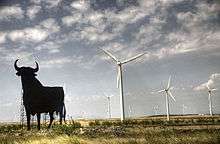
Electric power generated from wind power can be highly variable at several different timescales: hourly, daily, or seasonally. Annual variation also exists, but is not as significant. Because instantaneous electrical generation and consumption must remain in balance to maintain grid stability, this variability can present substantial challenges to incorporating large amounts of wind power into a grid system. Intermittency and the non-dispatchable nature of wind energy production can raise costs for regulation, incremental operating reserve, and (at high penetration levels) could require an increase in the already existing energy demand management, load shedding, storage solutions or system interconnection with HVDC cables.
Fluctuations in load and allowance for failure of large fossil-fuel generating units require operating reserve capacity, which can be increased to compensate for the variability of wind generation.
Wind power is variable, and during low wind periods, it must be replaced by other power sources. Transmission networks presently cope with outages of other generation plants and daily changes in electrical demand, but the variability of intermittent power sources such as wind power, is more frequent than those of conventional power generation plants which, when scheduled to be operating, may be able to deliver their nameplate capacity around 95% of the time.
Presently, grid systems with large wind penetration require a small increase in the frequency of usage of natural gas spinning reserve power plants to prevent a loss of electric power if there is no wind. At low wind power penetration, this is less of an issue.[119][120][121]
GE has installed a prototype wind turbine with an onboard battery similar to that of an electric car, equivalent to 60 seconds of production. Despite the small capacity, it is enough to guarantee that power output complies with forecast for 15 minutes, as the battery is used to eliminate the difference rather than provide full output. In certain cases, the increased predictability can be used to take wind power penetration from 20 to 30 or 40 percent. The battery cost can be retrieved by selling burst power on demand and reducing backup needs from gas plants.[122]
In the UK there were 124 separate occasions from 2008 to 2010 when the nation's wind output fell to less than 2% of installed capacity.[123] A report on Denmark's wind power noted that their wind power network provided less than 1% of average demand on 54 days during the year 2002.[124] Wind power advocates argue that these periods of low wind can be dealt with by simply restarting existing power stations that have been held in readiness, or interlinking with HVDC.[125] Electrical grids with slow-responding thermal power plants and without ties to networks with hydroelectric generation may have to limit the use of wind power.[124] According to a 2007 Stanford University study published in the Journal of Applied Meteorology and Climatology, interconnecting ten or more wind farms can allow an average of 33% of the total energy produced (i.e. about 8% of total nameplate capacity) to be used as reliable, baseload electric power which can be relied on to handle peak loads, as long as minimum criteria are met for wind speed and turbine height.[126][127]
Conversely, on particularly windy days, even with penetration levels of 16%, wind power generation can surpass all other electric power sources in a country. In Spain, in the early hours of 16 April 2012 wind power production reached the highest percentage of electric power production till then, at 60.5% of the total demand.[128] In Denmark, which had power market penetration of 30% in 2013, over 90 hours, wind power generated 100% of the country's power, peaking at 122% of the country's demand at 2 am on 28 October.[129]
| Country | 10% | 20% |
|---|---|---|
| Germany | 2.5 | 3.2 |
| Denmark | 0.4 | 0.8 |
| Finland | 0.3 | 1.5 |
| Norway | 0.1 | 0.3 |
| Sweden | 0.3 | 0.7 |
A 2006 International Energy Agency forum presented costs for managing intermittency as a function of wind energy's share of total capacity for several countries, as shown in the table on the right. Three reports on the wind variability in the UK issued in 2009, generally agree that variability of wind needs to be taken into account by adding 20% to the operating reserve, but it does not make the grid unmanageable. The modest additional costs can be quantified.[11]
The combination of diversifying variable renewables by type and location, forecasting their variation, and integrating them with dispatchable renewables, flexible fueled generators, and demand response can create a power system that has the potential to meet power supply needs reliably. Integrating ever-higher levels of renewables is being successfully demonstrated in the real world:
In 2009, eight American and three European authorities, writing in the leading electrical engineers' professional journal, didn't find "a credible and firm technical limit to the amount of wind energy that can be accommodated by electric power grids". In fact, not one of more than 200 international studies, nor official studies for the eastern and western U.S. regions, nor the International Energy Agency, has found major costs or technical barriers to reliably integrating up to 30% variable renewable supplies into the grid, and in some studies much more.
— [130]
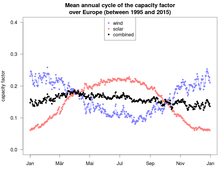
Solar power tends to be complementary to wind.[132][133] On daily to weekly timescales, high-pressure areas tend to bring clear skies and low surface winds, whereas low-pressure areas tend to be windier and cloudier. On seasonal timescales, solar energy peaks in summer, whereas in many areas wind energy is lower in summer and higher in winter.[upper-alpha 4][134] Thus the seasonal variation of wind and solar power tend to cancel each other somewhat.[131] In 2007 the Institute for Solar Energy Supply Technology of the University of Kassel pilot-tested a combined power plant linking solar, wind, biogas and hydrostorage to provide load-following power around the clock and throughout the year, entirely from renewable sources.[135]
Predictability
Wind power forecasting methods are used, but the predictability of any particular wind farm is low for short-term operation. For any particular generator, there is an 80% chance that wind output will change less than 10% in an hour and a 40% chance that it will change 10% or more in 5 hours.[136]
However, studies by Graham Sinden (2009) suggest that, in practice, the variations in thousands of wind turbines, spread out over several different sites and wind regimes, are smoothed. As the distance between sites increases, the correlation between wind speeds measured at those sites, decreases.[upper-alpha 5]
Thus, while the output from a single turbine can vary greatly and rapidly as local wind speeds vary, as more turbines are connected over larger and larger areas the average power output becomes less variable and more predictable.[59][137]
Wind power hardly ever suffers major technical failures, since failures of individual wind turbines have hardly any effect on overall power, so that the distributed wind power is reliable and predictable,[138] whereas conventional generators, while far less variable, can suffer major unpredictable outages.
Energy storage

Typically, conventional hydroelectricity complements wind power very well. When the wind is blowing strongly, nearby hydroelectric stations can temporarily hold back their water. When the wind drops they can, provided they have the generation capacity, rapidly increase production to compensate. This gives a very even overall power supply and virtually no loss of energy and uses no more water.
Alternatively, where a suitable head of water is not available, pumped-storage hydroelectricity or other forms of grid energy storage such as compressed air energy storage and thermal energy storage can store energy developed by high-wind periods and release it when needed. The type of storage needed depends on the wind penetration level – low penetration requires daily storage, and high penetration requires both short and long term storage – as long as a month or more. Stored energy increases the economic value of wind energy since it can be shifted to displace higher-cost generation during peak demand periods. The potential revenue from this arbitrage can offset the cost and losses of storage. For example, in the UK, the 2 GW Dinorwig pumped-storage plant evens out electrical demand peaks, and allows base-load suppliers to run their plants more efficiently. Although pumped-storage power systems are only about 75% efficient, and have high installation costs, their low running costs and ability to reduce the required electrical base-load can save both fuel and total electrical generation costs.[139][140]
In particular geographic regions, peak wind speeds may not coincide with peak demand for electrical power. In the U.S. states of California and Texas, for example, hot days in summer may have low wind speed and high electrical demand due to the use of air conditioning. Some utilities subsidize the purchase of geothermal heat pumps by their customers, to reduce electric power demand during the summer months by making air conditioning up to 70% more efficient;[141] widespread adoption of this technology would better match electric power demand to wind availability in areas with hot summers and low summer winds. A possible future option may be to interconnect widely dispersed geographic areas with an HVDC "super grid". In the U.S. it is estimated that to upgrade the transmission system to take in planned or potential renewables would cost at least USD 60 bn,[142] while the social value of added wind power would be more than that cost.[143]
Germany has an installed capacity of wind and solar that can exceed daily demand, and has been exporting peak power to neighboring countries, with exports which amounted to some 14.7 billion kWh in 2012.[144] A more practical solution is the installation of thirty days storage capacity able to supply 80% of demand, which will become necessary when most of Europe's energy is obtained from wind power and solar power. Just as the EU requires member countries to maintain 90 days strategic reserves of oil it can be expected that countries will provide electric power storage, instead of expecting to use their neighbors for net metering.[145]
Capacity credit, fuel savings and energy payback
The capacity credit of wind is estimated by determining the capacity of conventional plants displaced by wind power, whilst maintaining the same degree of system security.[146][147] According to the American Wind Energy Association, production of wind power in the United States in 2015 avoided consumption of 280 million cubic metres (73 billion US gallons) of water and reduced CO
2 emissions by 132 million metric tons, while providing USD 7.3 bn in public health savings.[148][149]
The energy needed to build a wind farm divided into the total output over its life, Energy Return on Energy Invested, of wind power varies but averages about 20–25.[150][151] Thus, the energy payback time is typically around a year.
Economics
According to BusinessGreen, wind turbines reached grid parity (the point at which the cost of wind power matches traditional sources) in some areas of Europe in the mid-2000s, and in the US around the same time. Falling prices continue to drive the Levelized cost down and it has been suggested that it has reached general grid parity in Europe in 2010, and will reach the same point in the US around 2016 due to an expected reduction in capital costs of about 12%.[152] According to PolitiFact, it is difficult to predict whether wind power would remain viable in the United States without subsidies.[153]
Electric power cost and trends

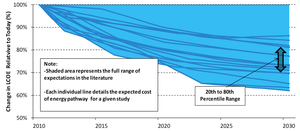
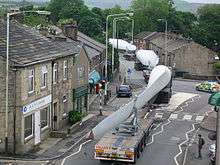
Wind power is capital intensive, but has no fuel costs.[155] The price of wind power is therefore much more stable than the volatile prices of fossil fuel sources.[156] The marginal cost of wind energy once a station is constructed is usually less than 1-cent per kW·h.[157]
However, the estimated average cost per unit of electric power must incorporate the cost of construction of the turbine and transmission facilities, borrowed funds, return to investors (including cost of risk), estimated annual production, and other components, averaged over the projected useful life of the equipment, which may be more than 20 years. Energy cost estimates are highly dependent on these assumptions so published cost figures can differ substantially. In 2004, wind energy cost 1/5 of what it did in the 1980s, and some expected that downward trend to continue as larger multi-megawatt turbines were mass-produced.[158] In 2012 capital costs for wind turbines were substantially lower than 2008–2010 but still above 2002 levels.[159] A 2011 report from the American Wind Energy Association stated, "Wind's costs have dropped over the past two years, in the range of 5 to 6 cents per kilowatt-hour recently.... about 2 cents cheaper than coal-fired electric power, and more projects were financed through debt arrangements than tax equity structures last year.... winning more mainstream acceptance from Wall Street's banks... Equipment makers can also deliver products in the same year that they are ordered instead of waiting up to three years as was the case in previous cycles.... 5,600 MW of new installed capacity is under construction in the United States, more than double the number at this point in 2010. Thirty-five percent of all new power generation built in the United States since 2005 has come from wind, more than new gas and coal plants combined, as power providers are increasingly enticed to wind as a convenient hedge against unpredictable commodity price moves."[160]
A British Wind Energy Association report gives an average generation cost of onshore wind power of around 3 pence (between US 5 and 6 cents) per kW·h (2005).[161] Cost per unit of energy produced was estimated in 2006 to be 5 to 6 percent above the cost of new generating capacity in the US for coal and natural gas: wind cost was estimated at $56 per MW·h, coal at $53/MW·h and natural gas at $53.[162] Similar comparative results with natural gas were obtained in a governmental study in the UK in 2011.[163] In 2011 power from wind turbines could be already cheaper than fossil or nuclear plants; it is also expected that wind power will be the cheapest form of energy generation in the future.[13] The presence of wind energy, even when subsidized, can reduce costs for consumers (€5 billion/yr in Germany) by reducing the marginal price, by minimizing the use of expensive peaking power plants.
A 2012 EU study shows base cost of onshore wind power similar to coal, when subsidies and externalities are disregarded. Wind power has some of the lowest external costs.[164]
In February 2013 Bloomberg New Energy Finance (BNEF) reported that the cost of generating electric power from new wind farms is cheaper than new coal or new baseload gas plants. When including the current Australian federal government carbon pricing scheme their modeling gives costs (in Australian dollars) of $80/MWh for new wind farms, $143/MWh for new coal plants and $116/MWh for new baseload gas plants. The modeling also shows that "even without a carbon price (the most efficient way to reduce economy-wide emissions) wind energy is 14% cheaper than new coal and 18% cheaper than new gas."[165] Part of the higher costs for new coal plants is due to high financial lending costs because of "the reputational damage of emissions-intensive investments". The expense of gas fired plants is partly due to "export market" effects on local prices. Costs of production from coal fired plants built in "the 1970s and 1980s" are cheaper than renewable energy sources because of depreciation.[165] In 2015 BNEF calculated the levelized cost of electricity (LCOE) per MWh in new powerplants (excluding carbon costs): $85 for onshore wind ($175 for offshore), $66–75 for coal in the Americas ($82–105 in Europe), gas $80–100.[166][167][168] A 2014 study showed unsubsidized LCOE costs between $37–81, depending on region.[169] A 2014 US DOE report showed that in some cases power purchase agreement prices for wind power had dropped to record lows of $23.5/MWh.[170]
The cost has reduced as wind turbine technology has improved. There are now longer and lighter wind turbine blades, improvements in turbine performance and increased power generation efficiency. Also, wind project capital and maintenance costs have continued to decline.[171] For example, the wind industry in the US in early 2014 were able to produce more power at lower cost by using taller wind turbines with longer blades, capturing the faster winds at higher elevations. This has opened up new opportunities and in Indiana, Michigan, and Ohio, the price of power from wind turbines built 90–120 metres (300–400 ft) above the ground can since 2014 compete with conventional fossil fuels like coal. Prices have fallen to about 4 cents per kilowatt-hour in some cases and utilities have been increasing the amount of wind energy in their portfolio, saying it is their cheapest option.[172]
Some initiatives are working to reduce the costs of electric power from offshore wind. One example is the Carbon Trust Offshore Wind Accelerator, a joint industry project, involving nine offshore wind developers, which aims to reduce the cost of offshore wind by 10% by 2015. It has been suggested that innovation at scale could deliver 25% cost reduction in offshore wind by 2020.[173] Henrik Stiesdal, former Chief Technical Officer at Siemens Wind Power, has stated that by 2025 energy from offshore wind will be one of the cheapest, scalable solutions in the UK, compared to other renewables and fossil fuel energy sources if the true cost to society is factored into the cost of the energy equation.[174] He calculates the cost at that time to be 43 EUR/MWh for onshore, and 72 EUR/MWh for offshore wind.[175]
In August 2017, the Department of Energy's National Renewable Energy Laboratory (NREL) published a new report on a 50% reduction in wind power cost by 2030. The NREL is expected to achieve advances in wind turbine design, materials, and controls to unlock performance improvements and reduce costs. According to international surveyors, this study shows that cost-cutting is projected to fluctuate between 24% and 30% by 2030. In more aggressive cases, experts estimate cost reduction Up to 40% if the research and development and technology programs result in additional efficiency.[176]
In 2018 a Lazard study found that "The low end Levelized cost of onshore wind-generated energy is $29/MWh, compared to an average illustrative marginal cost of $36/MWh for coal", and noted that the average cost had fallen by 7% in a year.[2]
Incentives and community benefits

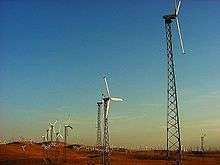
The wind industry in the United States generates tens of thousands of jobs and billions of dollars of economic activity.[179] Wind projects provide local taxes, or payments in place of taxes and strengthen the economy of rural communities by providing income to farmers with wind turbines on their land.[177][180] Wind energy in many jurisdictions receives financial or other support to encourage its development. Wind energy benefits from subsidies in many jurisdictions, either to increase its attractiveness or to compensate for subsidies received by other forms of production which have significant negative externalities.
In the US, wind power receives a production tax credit (PTC) of 2¢/kWh in 1993 dollars for each kW·h produced, for the first 10 years; at 2¢ per kW·h in 2012, the credit was renewed on 2 January 2012, to include construction begun in 2013.[181] A 30% tax credit can be applied instead of receiving the PTC.[182][183] Another tax benefit is accelerated depreciation. Many American states also provide incentives, such as exemption from property tax, mandated purchases, and additional markets for "green credits".[184] The Energy Improvement and Extension Act of 2008 contains extensions of credits for wind, including microturbines. Countries such as Canada and Germany also provide incentives for wind turbine construction, such as tax credits or minimum purchase prices for wind generation, with assured grid access (sometimes referred to as feed-in tariffs). These feed-in tariffs are typically set well above average electric power prices.[185][186] In December 2013 U.S. Senator Lamar Alexander and other Republican senators argued that the "wind energy production tax credit should be allowed to expire at the end of 2013"[187] and it expired 1 January 2014 for new installations.
Secondary market forces also provide incentives for businesses to use wind-generated power, even if there is a premium price for the electricity. For example, socially responsible manufacturers pay utility companies a premium that goes to subsidize and build new wind power infrastructure. Companies use wind-generated power, and in return, they can claim that they are undertaking strong "green" efforts. In the US the organization Green-e monitors business compliance with these renewable energy credits.[188] Turbine prices have fallen significantly in recent years due to tougher competitive conditions such as the increased use of energy auctions, and the elimination of subsidies in many markets. For example, Vestas, a wind turbine manufacturer, whose largest onshore turbine can pump out 4.2 megawatts of power, enough to provide electricity to roughly 5,000 homes, has seen prices for its turbines fall from €950,000 per megawatt in late 2016, to around €800,000 per megawatt in the third quarter of 2017.[189]
Small-scale wind power
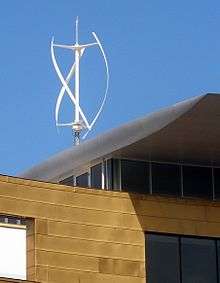
Small-scale wind power is the name given to wind generation systems with the capacity to produce up to 50 kW of electrical power.[190] Isolated communities, that may otherwise rely on diesel generators, may use wind turbines as an alternative. Individuals may purchase these systems to reduce or eliminate their dependence on grid electric power for economic reasons, or to reduce their carbon footprint. Wind turbines have been used for household electric power generation in conjunction with battery storage over many decades in remote areas.[191]
Recent examples of small-scale wind power projects in an urban setting can be found in New York City, where, since 2009, several building projects have capped their roofs with Gorlov-type helical wind turbines. Although the energy they generate is small compared to the buildings' overall consumption, they help to reinforce the building's 'green' credentials in ways that "showing people your high-tech boiler" cannot, with some of the projects also receiving the direct support of the New York State Energy Research and Development Authority.[192]
Grid-connected domestic wind turbines may use grid energy storage, thus replacing purchased electric power with locally produced power when available. The surplus power produced by domestic microgenerators can, in some jurisdictions, be fed into the network and sold to the utility company, producing a retail credit for the microgenerators' owners to offset their energy costs.[193]
Off-grid system users can either adapt to intermittent power or use batteries, photovoltaic, or diesel systems to supplement the wind turbine.[194] Equipment such as parking meters, traffic warning signs, street lighting, or wireless Internet gateways may be powered by a small wind turbine, possibly combined with a photovoltaic system, that charges a small battery replacing the need for a connection to the power grid.[195]
A Carbon Trust study into the potential of small-scale wind energy in the UK, published in 2010, found that small wind turbines could provide up to 1.5 terawatt-hours (TW·h) per year of electric power (0.4% of total UK electric power consumption), saving 600,000 tons of carbon dioxide (Mt CO2) emission savings. This is based on the assumption that 10% of households would install turbines at costs competitive with grid electric power, around 12 pence (US 19 cents) a kW·h.[196] A report prepared for the UK's government-sponsored Energy Saving Trust in 2006, found that home power generators of various kinds could provide 30 to 40% of the country's electric power needs by 2050.[197]
Distributed generation from renewable resources is increasing as a consequence of the increased awareness of climate change. The electronic interfaces required to connect renewable generation units with the utility system can include additional functions, such as the active filtering to enhance the power quality.[198]
Environmental effects
The environmental impact of wind power is considered to be relatively minor compared to that of fossil fuels. According to the IPCC, in assessments of the life-cycle greenhouse-gas emissions of energy sources, wind turbines have a median value of 12 and 11 (gCO
2eq/kWh) for offshore and onshore turbines, respectively.[200][201]
Compared with other low carbon power sources, wind turbines have some of the lowest global warming potential per unit of electrical energy generated.[202]
Onshore wind farms can have a significant visual impact and impact on the landscape.[203] Their network of turbines, access roads, transmission lines and substations can result in "energy sprawl".[7] Wind farms typically need to cover more land and be more spread out than other power stations.[6] To power major cities by wind alone would require building wind farms bigger than the cities themselves.[204] A report by the Mountaineering Council of Scotland concluded that wind farms hurt tourism in areas known for natural landscapes and panoramic views.[205] However, land between the turbines and roads can still be used for agriculture.[206][207]
Wind farms are typically built in wild and rural areas, which can lead to "industrialization of the countryside"[8] and habitat loss.[7] Habitat loss and habitat fragmentation are the greatest impact of wind farms on wildlife.[7] There are also reports of higher bird and bat mortality at wind turbines as there are around other artificial structures. The scale of the ecological impact may[208] or may not[209] be significant, depending on specific circumstances. Prevention and mitigation of wildlife fatalities, and protection of peat bogs,[210] affect the siting and operation of wind turbines.
Wind turbines generate noise. At a residential distance of 300 metres (980 ft) this may be around 45 dB, which is slightly louder than a refrigerator. At 1.5 km (1 mi) distance they become inaudible.[211][212] There are anecdotal reports of negative health effects from noise on people who live very close to wind turbines.[213] Peer-reviewed research has generally not supported these claims.[214][215][216]
The United States Air Force and Navy have expressed concern that siting large wind turbines near bases "will negatively impact radar to the point that air traffic controllers will lose the location of aircraft."[217]
Before 2019, many wind turbine blades had been made of fiberglass with designs that only provided a service lifetime of 10 to 20 years.[218] Given the available technology, as of February 2018, there was no market for recycling these old blades,[219] and they are commonly disposed of in landfills. Because blades are designed to be hollow, they take up large volume compared to their mass. Landfill operators have therefore started requiring operators to crush the blades before they can be landfilled.[218]
Politics
Central government
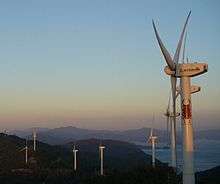
Nuclear power and fossil fuels are subsidized by many governments, and wind power and other forms of renewable energy are also often subsidized. For example, a 2009 study by the Environmental Law Institute[220] assessed the size and structure of U.S. energy subsidies over the 2002–2008 period. The study estimated that subsidies to fossil-fuel-based sources amounted to approximately $72 billion over this period and subsidies to renewable fuel sources totaled $29 billion. In the United States, the federal government has paid US$74 billion for energy subsidies to support R&D for nuclear power ($50 billion) and fossil fuels ($24 billion) from 1973 to 2003. During this same time frame, renewable energy technologies and energy efficiency received a total of US$26 billion. It has been suggested that a subsidy shift would help to level the playing field and support growing energy sectors, namely solar power, wind power, and biofuels.[221] History shows that no energy sector was developed without subsidies.[221]
According to the International Energy Agency (IEA) (2011), energy subsidies artificially lower the price of energy paid by consumers, raise the price received by producers or lower the cost of production. "Fossil fuels subsidies costs generally outweigh the benefits. Subsidies to renewables and low-carbon energy technologies can bring long-term economic and environmental benefits".[222] In November 2011, an IEA report entitled Deploying Renewables 2011 said "subsidies in green energy technologies that were not yet competitive are justified to give an incentive to investing into technologies with clear environmental and energy security benefits". The IEA's report disagreed with claims that renewable energy technologies are only viable through costly subsidies and not able to produce energy reliably to meet demand.
However, IEA's views are not universally accepted. Between 2010 and 2016, subsidies for wind were between 1¢ and 6¢ per kWh. Subsidies for coal, natural gas, and nuclear are all between 0.05¢ and 0.2¢ per kWh overall years. On a per-kWh basis, wind is subsidized 50 times as much as traditional sources.[223]
In the United States, the wind power industry has recently increased its lobbying efforts considerably, spending about $5 million in 2009 after years of relative obscurity in Washington.[224] By comparison, the U.S. nuclear industry alone spent over $650 million on its lobbying efforts and campaign contributions during 10 years ending in 2008.[225][226][227]
Following the 2011 Japanese nuclear accidents, Germany's federal government is working on a new plan for increasing energy efficiency and renewable energy commercialization, with a particular focus on offshore wind farms. Under the plan, large wind turbines will be erected far away from the coastlines, where the wind blows more consistently than it does on land, and where the enormous turbines won't bother the inhabitants. The plan aims to decrease Germany's dependence on energy derived from coal and nuclear power plants.[228]
Public opinion
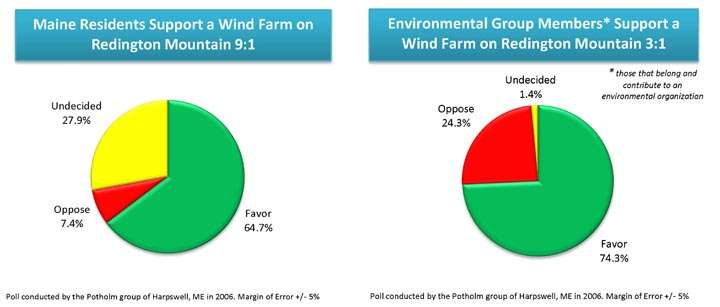
Surveys of public attitudes across Europe and in many other countries show strong public support for wind power.[229][230][231] About 80% of EU citizens support wind power.[232] In Germany, where wind power has gained very high social acceptance, hundreds of thousands of people have invested in citizens' wind farms across the country and thousands of small and medium-sized enterprises are running successful businesses in a new sector that in 2008 employed 90,000 people and generated 8% of Germany's electric power.[233][234]
Bakker et al. (2012) discovered in their study that when residents did not want the turbines located by them their annoyance was significantly higher than those "that benefited economically from wind turbines the proportion of people who were rather or very annoyed was significantly lower".[235]
Although wind power is a popular form of energy generation, the construction of wind farms is not universally welcomed, often for aesthetic reasons.[206][229][230][231][232][236][237]
In Spain, with some exceptions, there has been little opposition to the installation of inland wind parks. However, the projects to build offshore parks have been more controversial.[238] In particular, the proposal of building the biggest offshore wind power production facility in the world in southwestern Spain in the coast of Cádiz, on the spot of the 1805 Battle of Trafalgar[239] has been met with strong opposition who fear for tourism and fisheries in the area,[240] and because the area is a war grave.[239]
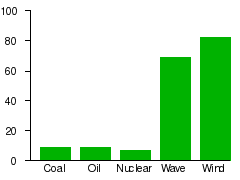 |
In a survey conducted by Angus Reid Strategies in October 2007, 89 percent of respondents said that using renewable energy sources like wind or solar power was positive for Canada, because these sources were better for the environment. Only 4 percent considered using renewable sources as negative since they can be unreliable and expensive.[242] According to a Saint Consulting survey in April 2007, wind power was the alternative energy source most likely to gain public support for future development in Canada, with only 16% opposed to this type of energy. By contrast, 3 out of 4 Canadians opposed nuclear power developments.[243]
A 2003 survey of residents living around Scotland's 10 existing wind farms found high levels of community acceptance and strong support for wind power, with much support from those who lived closest to the wind farms. The results of this survey support those of an earlier Scottish Executive survey 'Public attitudes to the Environment in Scotland 2002', which found that the Scottish public would prefer the majority of their electric power to come from renewables, and which rated wind power as the cleanest source of renewable energy.[244] A survey conducted in 2005 showed that 74% of people in Scotland agree that wind farms are necessary to meet current and future energy needs. When people were asked the same question in a Scottish renewables study conducted in 2010, 78% agreed. The increase is significant as there were twice as many wind farms in 2010 as there were in 2005. The 2010 survey also showed that 52% disagreed with the statement that wind farms are "ugly and a blot on the landscape". 59% agreed that wind farms were necessary and that how they looked was unimportant.[245] Regarding tourism, query responders consider power pylons, cell phone towers, quarries and plantations more negatively than wind farms.[246] Scotland is planning to obtain 100% of electric power from renewable sources by 2020.[247]
In other cases there is direct community ownership of wind farm projects. The hundreds of thousands of people who have become involved in Germany's small and medium-sized wind farms demonstrate such support there.[248]
A 2010 Harris Poll reflects the strong support for wind power in Germany, other European countries, and the United States.[229][230][249]
| U.S. | Great Britain | France | Italy | Spain | Germany | |
|---|---|---|---|---|---|---|
| % | % | % | % | % | % | |
| Strongly oppose | 3 | 6 | 6 | 2 | 2 | 4 |
| Oppose more than favour | 9 | 12 | 16 | 11 | 9 | 14 |
| Favour more than oppose | 37 | 44 | 44 | 38 | 37 | 42 |
| Strongly favour | 50 | 38 | 33 | 49 | 53 | 40 |
In China, Shen et al. (2019) discover that Chinese city-dwellers may be somewhat resistant to building wind turbines in urban areas, with a surprisingly high proportion of people citing an unfounded fear of radiation as driving their concerns.[251] The central Chinese government rather than scientists is better suited to address this concern. Also, the study finds that like their counterparts in OECD countries, urban Chinese respondents are sensitive to direct costs and wildlife externalities. Distributing relevant information about turbines to the public may alleviate resistance.
Community
Many wind power companies work with local communities to reduce environmental and other concerns associated with particular wind farms.[254][255][256] In other cases there is direct community ownership of wind farm projects. Appropriate government consultation, planning and approval procedures also help to minimize environmental risks.[229][257][258] Some may still object to wind farms[259] but, according to The Australia Institute, their concerns should be weighed against the need to address the threats posed by climate change and the opinions of the broader community.[260]
In America, wind projects are reported to boost local tax bases, helping to pay for schools, roads, and hospitals. Wind projects also revitalize the economy of rural communities by providing steady income to farmers and other landowners.[177]
In the UK, both the National Trust and the Campaign to Protect Rural England have expressed concerns about the effects on the rural landscape caused by inappropriately sited wind turbines and wind farms.[261][262]
Some wind farms have become tourist attractions. The Whitelee Wind Farm Visitor Centre has an exhibition room, a learning hub, a café with a viewing deck and also a shop. It is run by the Glasgow Science Centre.[263]
In Denmark, a loss-of-value scheme gives people the right to claim compensation for loss of value of their property if it is caused by proximity to a wind turbine. The loss must be at least 1% of the property's value.[264]
Despite this general support for the concept of wind power in the public at large, local opposition often exists and has delayed or aborted a number of projects.[265][266][267] For example, there are concerns that some installations can negatively affect TV and radio reception and Doppler weather radar, as well as produce excessive sound and vibration levels leading to a decrease in property values.[268] Potential broadcast-reception solutions include predictive interference modeling as a component of site selection.[269][270] A study of 50,000 home sales near wind turbines found no statistical evidence that prices were affected.[271]
While aesthetic issues are subjective and some find wind farms pleasant and optimistic, or symbols of energy independence and local prosperity, protest groups are often formed to attempt to block new wind power sites for various reasons.[259][272][273]
This type of opposition is often described as NIMBYism,[274] but research carried out in 2009 found that there is little evidence to support the belief that residents only object to renewable power facilities such as wind turbines as a result of a "Not in my Back Yard" attitude.[275]
Geopolitics
It has been argued that expanding the use of wind power will lead to increasing geopolitical competition over critical materials for wind turbines such as rare earth elements neodymium, praseodymium, and dysprosium. But this perspective has been criticised for failing to recognise that most wind turbines do not use permanent magnets and for underestimating the power of economic incentives for expanded production of these minerals.[276]
Turbine design
Wind turbines are devices that convert the wind's kinetic energy into electrical power. The result of over a millennium of windmill development and modern engineering, today's wind turbines are manufactured in a wide range of horizontal axis and vertical axis types. The smallest turbines are used for applications such as battery charging for auxiliary power. Slightly larger turbines can be used for making small contributions to a domestic power supply while selling unused power back to the utility supplier via the electrical grid. Arrays of large turbines, known as wind farms, have become an increasingly important source of renewable energy and are used in many countries as part of a strategy to reduce their reliance on fossil fuels.
Wind turbine design is the process of defining the form and specifications of a wind turbine to extract energy from the wind.[277] A wind turbine installation consists of the necessary systems needed to capture the wind's energy, point the turbine into the wind, convert mechanical rotation into electrical power, and other systems to start, stop, and control the turbine.
In 1919 the German physicist Albert Betz showed that for a hypothetical ideal wind-energy extraction machine, the fundamental laws of conservation of mass and energy allowed no more than 16/27 (59%) of the kinetic energy of the wind to be captured. This Betz limit can be approached in modern turbine designs, which may reach 70 to 80% of the theoretical Betz limit.[278][279]
The aerodynamics of a wind turbine are not straightforward. The airflow at the blades is not the same as the airflow far away from the turbine. The very nature of how energy is extracted from the air also causes air to be deflected by the turbine. Also, the aerodynamics of a wind turbine at the rotor surface exhibit phenomena that are rarely seen in other aerodynamic fields. The shape and dimensions of the blades of the wind turbine are determined by the aerodynamic performance required to efficiently extract energy from the wind, and by the strength required to resist the forces on the blade.[280]
In addition to the aerodynamic design of the blades, the design of a complete wind power system must also address the design of the installation's rotor hub, nacelle, tower structure, generator, controls, and foundation.[281]
See also
- 100% renewable energy
- Airborne wind turbine
- Cost of electricity by source
- Global Wind Day
- List of countries by electricity production from renewable sources
- List of wind turbine manufacturers
- Lists of offshore wind farms by country
- Lists of wind farms by country
- Outline of wind energy
- Renewable energy by country
- Wind resource assessment
Notes
- "Global Wind Report 2014 – Annual Market Update" (PDF). report. GWEC. 22 April 2016. p. 9. Retrieved 23 May 2016.
2015 was an unprecedented year for the wind industry as annual installations crossed the 60 GW mark for the first time, and more than 63 GW of new wind power capacity was brought online. The last record was set in 2014 when over 52 GW of new capacity was installed globally. In 2015 total investments in the clean energy sector reached a record USD 329 bn (EUR 296.6 bn). The new global total for wind power at the end of 2015 was 433 GW
- For example, a 1 MW turbine with a capacity factor of 35% will not produce 8,760 MW·h in a year (1 × 24 × 365), but only 1 × 0.35 × 24 × 365 = 3,066 MW·h, averaging to 0.35 MW
- The UK System Operator, National Grid (UK) have quoted estimates of balancing costs for 40% wind and these lie in the range £500-1000M per annum. "These balancing costs represent an additional £6 to £12 per annum on average consumer electricity bill of around £390.""National Grid's response to the House of Lords Economic Affairs Select Committee investigating the economics of renewable energy" (PDF). National Grid. 2008. Archived from the original (PDF) on 25 March 2009.
- California is an exception
- Diesendorf, Mark (2007), Greenhouse Solutions with Sustainable Energy, p. 119,
Graham Sinden analyzed over 30 years of hourly wind speed data from 66 sites spread out over the United Kingdom. He found that the correlation coefficient of wind power fell from 0.6 at 200 km to 0.25 at 600 km separation (a perfect correlation would have a coefficient equal to 1.) There were no hours in the data set where the wind speed was below the cut-in wind speed of a modern wind turbine throughout the United Kingdom, and low wind speed events affecting more than 90 percent of the United Kingdom had an average recurrent rate of only one hour per year.
References
- "Wind energy generation by region". Our World in Data. Retrieved 5 March 2020.
- "Levelized Cost of Energy and Levelized Cost of Storage 2018". 8 November 2018. Retrieved 11 November 2018.
- "Wind power is cheapest energy, EU analysis finds". the guardian. Retrieved 15 October 2014.
- Walwyn, David Richard; Brent, Alan Colin (2015). "Renewable energy gathers steam in South Africa". Renewable and Sustainable Energy Reviews. 41: 390. doi:10.1016/j.rser.2014.08.049. hdl:2263/49731.
- Gasch, Robert and Twele, Jochen (ed.) (2013) Windkraftanlagen. Grundlagen, Entwurf, Planung und Betrieb. Springer, Wiesbaden 2013, p. 569 (German).
- What are the pros and cons of onshore wind energy?. Grantham Research Institute on Climate Change and the Environment. January 2018.
- Nathan F. Jones, Liba Pejchar, Joseph M. Kiesecker. "The Energy Footprint: How Oil, Natural Gas, and Wind Energy Affect Land for Biodiversity and the Flow of Ecosystem Services". BioScience, Volume 65, Issue 3, March 2015. pp.290–301
- Szarka, Joseph. Wind Power in Europe: Politics, Business and Society. Springer, 2007. p.176
- Gipe, Paul (1993). "The Wind Industry's Experience with Aesthetic Criticism". Leonardo. 26 (3): 243–48. doi:10.2307/1575818. JSTOR 1575818.
- Holttinen, Hannele; et al. (September 2006). "Design and Operation of Power Systems with Large Amounts of Wind Power" (PDF). IEA Wind Summary Paper, Global Wind Power Conference 18–21 September 2006, Adelaide, Australia. Archived from the original (PDF) on 26 July 2011.
- Abbess, Jo (28 August 2009). "Wind Energy Variability and Intermittency in the UK". Claverton-energy.com. Archived from the original on 12 January 2011.
- "Impact of Wind Power Generation in Ireland on the Operation of Conventional Plant and the Economic Implications" (PDF). eirgrid.com. February 2004. Archived from the original (PDF) on 15 August 2011. Retrieved 22 November 2010.
- Armaroli, Nicola; Balzani, Vincenzo (2011). "Towards an electricity-powered world". Energy & Environmental Science. 4 (9): 3193. doi:10.1039/c1ee01249e.
- Platt, Reg (21 January 2013) Wind power delivers too much to ignore, New Scientist.
- Platt, Reg; Fitch-Roy, Oscar and Gardner, Paul (August 2012) Beyond the Bluster why Wind Power is an Effective Technology Archived 12 August 2013 at the Wayback Machine. Institute for Public Policy Research.
- Huang, Junling; Lu, Xi; McElroy, Michael B. (2014). "Meteorologically defined limits to reduction in the variability of outputs from a coupled wind farm system in the Central US" (PDF). Renewable Energy. 62: 331–40. doi:10.1016/j.renene.2013.07.022.
- [url=https://www.bp.com/en/global/corporate/energy-economics/statistical-review-of-world-energy/renewable-energy.html.html#wind-energy BP Global: Wind Energy]
- "Global Installed Capacity in 2018". GWEC. 26 February 2019. Retrieved 22 March 2019.
- New record-breaking year for Danish wind power Archived 25 January 2016 at the Wayback Machine. Energinet.dk (15 January 2016). Retrieved on 20 July 2016.
- REN21 (2011). "Renewables 2011: Global Status Report" (PDF). p. 11. Archived from the original (PDF) on 19 June 2013. Retrieved 8 January 2013.
- "Electricity generation by source". International Energy Agency.
- B. Trueb, Lucien (2015), Astonishing the Wild Pigs, Highlights of Technology, ATHENA-Verlag, p. 119, ISBN 9783898967662
- Ahmad Y Hassan, Donald Routledge Hill (1986). Islamic Technology: An illustrated history, p. 54. Cambridge University Press. ISBN 0-521-42239-6.
- Lucas, Adam (2006), Wind, Water, Work: Ancient and Medieval Milling Technology, Brill Publishers, p. 65, ISBN 90-04-14649-0
- Price, Trevor J (3 May 2005). "James Blyth – Britain's First Modern Wind Power Engineer". Wind Engineering. 29 (3): 191–200. doi:10.1260/030952405774354921.
- Shackleton, Jonathan. "World First for Scotland Gives Engineering Student a History Lesson". The Robert Gordon University. Archived from the original on 17 December 2008. Retrieved 20 November 2008.
- Anon. Mr. Brush's Windmill Dynamo, Scientific American, Vol. 63 No. 25, 20 December 1890, p. 54.
- A Wind Energy Pioneer: Charles F. Brush Archived 8 September 2008 at the Wayback Machine, Danish Wind Industry Association. Accessed 2 May 2007.
- "History of Wind Energy" in Cutler J. Cleveland (ed.) Encyclopedia of Energy. Vol. 6, Elsevier, ISBN 978-1-60119-433-6, 2007, pp. 421–22
- "History of U.S. Wind Energy". Energy.gov. Retrieved 10 December 2019.
- "Global Wind Atlas". Technical University of Denmark (DTU).
- "Harvesting the Wind: The Physics of Wind Turbines" (PDF). Retrieved 10 May 2017.
- "What is wind?". Renewable UK: Education and careers. Renewable UK. 2010. Archived from the original on 4 March 2011. Retrieved 9 April 2012.
- Huang, Junling; McElroy, Michael B (2015). "A 32-year perspective on the origin of wind energy in a warming climate" (PDF). Renewable Energy. 77: 482–92. doi:10.1016/j.renene.2014.12.045.
- Mapping the World's Wind Energy Potential World Bank, 28 November 2017.
- New Global Wind Atlas to be presented at WindEurope Conference Technical University of Denmark, 21 November 2017.
- Staffell, Iain; Pfenninger, Stefan (1 November 2016). "Using bias-corrected reanalysis to simulate current and future wind power output". Energy. 114: 1224–39. doi:10.1016/j.energy.2016.08.068.

- Hurley, Brian. "How Much Wind Energy is there?". Claverton Group. Retrieved 8 April 2012.
- Ananthaswamy, Anil & Le Page, Michael (30 January 2012). "Power paradox: Clean Might Not Be Green Forever". New Scientist.
- Jacobson, M.Z.; Archer, C.L. (2012). "Saturation wind power potential and its implications for wind energy". Proceedings of the National Academy of Sciences. 109 (39): 15679–84. Bibcode:2012PNAS..10915679J. doi:10.1073/pnas.1208993109. PMC 3465402. PMID 23019353.
- Adams, A.S.; Keith, D.W. (2013). "Are global wind power resource estimates overstated?" (PDF). Environmental Research Letters. 8 (1): 015021. Bibcode:2013ERL.....8a5021A. doi:10.1088/1748-9326/8/1/015021.
- Savenkov, M (2009). "On the truncated weibull distribution and its usefulness in evaluating potential wind (or wave) energy sites" (PDF). University Journal of Engineering and Technology. 1 (1): 21–25. Archived from the original on 22 February 2015.CS1 maint: BOT: original-url status unknown (link)
- "Wind Statistics and the Weibull Distribution". Wind-power-program.com. Retrieved 11 January 2013.
- Watts, Jonathan & Huang, Cecily. Winds Of Change Blow Through China As Spending On Renewable Energy Soars, The Guardian, 19 March 2012, revised on 20 March 2012. Retrieved 4 January 2012.
- Xinhua: Jiuquan Wind Power Base Completes First Stage, Xinhua News Agency, 4 November 2010. Retrieved from ChinaDaily.com.cn website 3 January 2013.
- "Muppandal (India)". thewindpower.net.
- Terra-Gen Press Release Archived 10 May 2012 at the Wayback Machine, 17 April 2012
- Started in August 2001, the Jaisalmer based facility crossed 1,000 MW capacity to achieve this milestone. Business-standard.com (11 May 2012). Retrieved on 20 July 2016.
- Mills, Erin (12 July 2009). "Shepherds Flat farm lifts off" (PDF). East Oregonian. Retrieved 11 December 2009.
- Belyeu, Kathy (26 February 2009) Drilling Down: What Projects Made 2008 Such a Banner Year for Wind Power? renewableenergyworld.com
- AWEA: U.S. Wind Energy Projects – Texas Archived 29 December 2007 at the Wayback Machine
- CEZ Group: The Largest Wind Farm in Europe Goes Into Trial Operation. Cez.cz. Retrieved on 20 July 2016.
- AWEA: U.S. Wind Energy Projects – Indiana Archived 18 September 2010 at the Wayback Machine
- Whitelee Windfarm Archived 27 February 2014 at the Wayback Machine. Whitelee Windfarm. Retrieved on 20 July 2016.
- "GWEC, Global Wind Report Annual Market Update". Gwec.net. Retrieved 20 May 2017.
- "Wind Farm Electrical Systems" (PDF). Retrieved 11 July 2020.
- Meyers, Johan; Meneveau, Charles (1 March 2012). "Optimal turbine spacing in fully developed wind farm boundary layers". Wind Energy. 15 (2): 305–17. Bibcode:2012WiEn...15..305M. doi:10.1002/we.469.
- "Making of the modern offshore substation". Windpower Engineering & Development. Retrieved 14 June 2019.
- Falahi, G.; Huang, A. (1 October 2014). Low voltage ride through control of modular multilevel converter based HVDC systems. IECON 2014 – 40th Annual Conference of the IEEE Industrial Electronics Society. pp. 4663–68. doi:10.1109/IECON.2014.7049205. ISBN 978-1-4799-4032-5.
- Cheng, Ming; Zhu, Ying (2014). "The state of the art of wind energy conversion systems and technologies: A review". Energy Conversion and Management. 88: 332. doi:10.1016/j.enconman.2014.08.037.
- Demeo, E.A.; Grant, W.; Milligan, M.R.; Schuerger, M.J. (2005). "Wind plant integration". IEEE Power and Energy Magazine. 3 (6): 38–46. doi:10.1109/MPAE.2005.1524619.
- Zavadil, R.; Miller, N.; Ellis, A.; Muljadi, E. (2005). "Making connections". IEEE Power and Energy Magazine. 3 (6): 26–37. doi:10.1109/MPAE.2005.1524618.
- Hulazan, Ned (16 February 2011). "Offshore wind power – Advantages and disadvantages". Renewable Energy Articles. Retrieved 9 April 2012.
- Millborrow, David (6 August 2010). "Cutting the cost of offshore wind energy". Wind Power Monthly. Haymarket.
- Madsen & Krogsgaard (22 November 2010) Offshore Wind Power 2010 BTM Consult. Archived 30 June 2011 at the Wayback Machine
- Wilson, Grant. "Winds of change: Britain now generates twice as much electricity from wind as coal". The Conversation. Retrieved 17 January 2018.
- "1.1 Offshore wind market – 2012". globalccsinstitute.com. European Wind Energy Association (EWEA). 1 July 2013. Retrieved 16 March 2014.
- "World's largest offshore wind farm officially opens". Retrieved 11 September 2018.
- "London Array's own website announcement of commencement of offshore works" (PDF). Retrieved 6 July 2013.
- Wittrup, Sanne. First foundation Ing.dk, 8 March 2011. Accessed: 8 March 2011.
- "London Array Project". Londonarray.com. 22 February 1999. Retrieved 6 July 2013.
- "Full tilt: giant offshore wind farm opens in North Sea". theguardian.com. 9 May 2017. Retrieved 16 January 2018.
- "World's second largest offshore wind farm opens off coast of Wales". Wales Online. 17 June 2015. Archived from the original on 19 June 2015. Retrieved 18 June 2015.
- Greater Gabbard. "SSE wind farm Project Website". Sse.com. Archived from the original on 14 August 2011. Retrieved 6 July 2013.
- DONG Energy. "Facts on Anholt Offshore Wind Farm". dongenergy.com. Archived from the original on 6 November 2013. Retrieved 2 February 2014.
- BARD Offshore (1 August 2013). "Pioneering wind farm project BARD Offshore 1 successfully completed on the high seas". BARD Offshore. Archived from the original on 21 August 2014. Retrieved 21 August 2014.
- Wald, Matthew (26 August 2008) Wind Energy Bumps Into Power Grid’s Limits. New York Times
- Power System Analysis and Design. Glover, Sarma, Overbye/ 5th Edition
- wind-power-in-maine_2013-08-04.html?pagenum=full Inadequate transmission lines keeping some Maine wind power off the grid – The Portland Press Herald / Maine Sunday Telegram. Pressherald.com (4 August 2013). Retrieved on 20 July 2016.
- "China now the world leader in wind power production". The Globe and Mail. 11 February 2016. Retrieved 28 February 2016.
- "EU wind power capacity reaches 100GW". UPI. 1 October 2012. Retrieved 31 October 2012.
- Wind energy in Europe in 2018. EWEA.
- Rick Tidball and others, "Cost and Performance Assumptions for Modeling Electricity Generation Technologies", US National Renewable Energy Laboratory, November 2010, p.63.
- "GWEC Global Wind Report 2019". Global Wind Energy Council. 2020. pp. 25, 28.
- "global wind report 2019". GlobalWindEnergyCouncil. 2020. p. 10.
- "GWEC, Global Wind Energy Outlook 2010" (PDF). Gwec.net. Retrieved 14 May 2011.
- "Market Forecast for 2016–2020". report. GWEC. Retrieved 27 May 2016.
- "Continuing boom in wind energy – 20 GW of new capacity in 2007". Gwec.net. Retrieved 29 August 2010.
- "Global Wind Energy Outlook 2014" (PDF). report. GWEC. October 2014. Retrieved 27 May 2016.
- Wind Power: Capacity Factor, Intermittency, and what happens when the wind doesn't blow? Archived 1 October 2008 at the Wayback Machine. Retrieved 24 January 2008.
- Shahan, Zachary (27 July 2012). "Wind Turbine Net Capacity Factor – 50% the New Normal?". Cleantechnica.com. Retrieved 11 January 2013.
- Massachusetts Maritime Academy — Bourne, Mass Archived 11 February 2007 at the Wayback Machine This 660 kW wind turbine has a capacity factor of about 19%.
- Wind Power in Ontario Archived 10 August 2014 at the Wayback Machine These wind farms have capacity factors of about 28–35%.
- "Electricity production from solar and wind in Germany in 2012" (PDF). Fraunhofer Institute for Solar Energy Systems ISE. 8 February 2013. Archived from the original (PDF) on 2 May 2013.
- (6 April 2011) Report Questions Wind Power’s Ability to Deliver Electricity When Most Needed John Muir Trust and Stuart Young Consulting, Retrieved 26 March 2013
- "Capacity factor of wind power realized values vs. estimates" (PDF). 10 April 2009. Archived from the original (PDF) on 2 May 2013. Retrieved 11 January 2013.
- WindpoweringAmerica.gov Archived 2 May 2013 at the Wayback Machine, 46. U.S. Department of Energy; Energy Efficiency and Renewable Energy "20% Wind Energy by 2030"
- "Transparent Cost Database". En.openei.org. 20 March 2009. Retrieved 11 January 2013.
- US Energy Information Administration, Table 6.7B, Capacity factors, Electric Power Monthly, June 2016.
- "Denmark sources record 47% of power from wind in 2019". Reuters. 2 January 2020. Retrieved 30 January 2020.
- "Approximate wind energy penetration in leading wind markets in 2018". statista. Retrieved 27 March 2020.
- Ltd, Renews (12 March 2019). "Irish wind smashes 2018 records". reNEWS - Renewable Energy News. Retrieved 30 January 2020.
- "Stromeinspeisung durch konventionelle und erneuerbare Energieträger" (in German). Retrieved 27 March 2020.
- "Wind erergy in spain installed 1634 MV in 2019". December 2019.
- "Wind energy in Europe in 2018" (PDF). 21 February 2019. Retrieved 26 May 2019.
- "Electric Power Monthly - U.S. Energy Information Administration". www.eia.gov. Retrieved 8 May 2019.
- "Renewable energy". BP. Retrieved 15 January 2020.
- "BP Statistical Review of World Energy June 2016 – Electricity" (PDF). BP. Archived from the original (PDF) on 10 September 2016. Retrieved 12 September 2016.
- "BP Statistical Review of World Energy June 2016 – Renewable energy" (PDF). BP. Retrieved 12 September 2016.
- "Tackling Climate Change in the U.S" (PDF). American Solar Energy Society. January 2007. Archived from the original (PDF) on 26 November 2008. Retrieved 5 September 2007.
- A study commissioned by the state of Minnesota considered penetration of up to 25%, and concluded that integration issues would be manageable and have incremental costs of less than one-half-cent ($0.0045) per kW·h. "Final Report – 2006 Minnesota Wind Integration Study" (PDF). The Minnesota Public Utilities Commission. 30 November 2006. Archived from the original (PDF) on 1 December 2007. Retrieved 15 January 2008.
- ESB National Grid, Ireland's electric utility, in a 2004 study that, concluded that to meet the renewable energy targets set by the EU in 2001 would "increase electricity generation costs by a modest 15%" "Impact of Wind Power Generation in Ireland on the Operation of Conventional Plant and the Economic Implications" (PDF). ESB National Grid. February 2004. p. 36. Archived from the original (PDF) on 25 March 2009. Retrieved 23 July 2008.
- Growth Scenarios for UK Renewables Generation and Implications for Future Developments and Operation of Electricity Networks. BERR Publication URN 08/1021. Sinclair Knight Merz (June 2008)
- Andresen, Tino. "Molten Aluminum Lakes Offer Power Storage for German Wind Farms" Bloomberg, 27 October 2014.
- Luoma, Jon R. (13 July 2001). "The Challenge for Green Energy: How to Store Excess Electricity". E360.yale.edu.
- Buczynski, Beth (23 August 2012). "Power To Gas Technology Turns Excess Wind Energy Into Natural Gas". Revmodo.com. Archived from the original on 5 October 2012.
- Wals, Matthew L. (4 November 2011) Taming Unruly Wind Power. New York Times. Archived 2 December 2012 at the Wayback Machine
- Center for National Policy, Washington DC, 11 June 2012, "What States Can Do: The Clean Revolution"
- "Claverton-Energy.com". Claverton-Energy.com. Retrieved 29 August 2010.
- "Is wind power reliable?". Archived from the original on 5 June 2010. Retrieved 29 August 2010.
- Milligan, Michael (October 2010) Operating Reserves and Wind Power Integration: An International Comparison. National Renewable Energy Laboratory, p. 11.
- Bullis, Kevin. "Wind Turbines, Battery Included, Can Keep Power Supplies Stable" Technology Review, 7 May 2013. Accessed: 29 June 2013.
- "Analysis of UK Wind Generation" 2011
- Sharman, Hugh (May 2005). "Why wind power works for Denmark". Proceedings of the Institution of Civil Engineers – Civil Engineering. 158 (2): 66–72. doi:10.1680/cien.2005.158.2.66.
- Realisable Scenarios for a Future Electricity Supply based 100% on Renewable Energies Archived 1 July 2014 at the Wayback Machine Gregor Czisch, University of Kassel, Germany and Gregor Giebel, Risø National Laboratory, Technical University of Denmark
- "The power of multiples: Connecting wind farms can make a more reliable and cheaper power source". 21 November 2007.
- Archer, C.L.; Jacobson, M.Z. (2007). "Supplying Baseload Power and Reducing Transmission Requirements by Interconnecting Wind Farms" (PDF). Journal of Applied Meteorology and Climatology. 46 (11): 1701–117. Bibcode:2007JApMC..46.1701A. CiteSeerX 10.1.1.475.4620. doi:10.1175/2007JAMC1538.1.
- "Red Eléctrica de España | Wind produces more than 60% of the electricity consumed in Spain during the early hours of this morning". www.ree.es. Retrieved 27 July 2015.
- Bentham Paulos (16 December 2013). "How Wind Met All of Denmark's Electricity Needs for 90 Hours". The Contributor. Retrieved 5 April 2014.
- Reinventing Fire. Chelsea Green Publishing. 2011. p. 199.
- Kaspar, F., Borsche, M., Pfeifroth, U., Trentmann, J., Drücke, J., and Becker, P.: A climatological assessment of balancing effects and shortfall risks of photovoltaics and wind energy in Germany and Europe, Adv. Sci. Res., 16, 119–128, https://doi.org/10.5194/asr-16-119-2019, 2019
- Wood, Shelby (21 January 2008) Wind + sun join forces at Washington power plant. The Oregonian.
- "Small Wind Systems". Seco.cpa.state.tx.us. Archived from the original on 23 October 2012. Retrieved 29 August 2010.
- "Lake Erie Wind Resource Report, Cleveland Water Crib Monitoring Site, Two-Year Report Executive Summary" (PDF). Green Energy Ohio. 10 January 2008. Archived from the original (PDF) on 17 December 2008. Retrieved 27 November 2008. This study measured up to four times as much average wind power during winter as in summer for the test site.
- "The Combined Power Plant: the first stage in providing 100% power from renewable energy". SolarServer. January 2008. Archived from the original on 14 October 2008. Retrieved 10 October 2008.
- "Wind Systems Integration Basics". Archived from the original on 7 June 2012.
- "Variability of Wind Power and other Renewables: Management Options and Strategies" (PDF). IEA. 2005. Archived from the original (PDF) on 30 December 2005.
- Peterson, Kristen (5 November 2012). "The reliability of wind power". Minnesota Daily.
- "Dinorwig Hydroelectric Plant, Wales". Thegreenage.co.uk. Archived from the original on 11 January 2013. Retrieved 11 January 2013.
- The Future of Electrical Energy Storage: The economics and potential of new technologies 2 January 2009 ID RET2107622
- "Geothermal Heat Pumps". Capital Electric Cooperative. Archived from the original on 6 December 2008. Retrieved 5 October 2008.
- Wind Energy Bumps Into Power Grid's Limits Published: 26 August 2008
- "A New Era for Wind Power in the United States" p. xiv. United States Department of Energy, 2013. Retrieved: March 2015.
- Birkenstock, Günther. Power Exports Peak, Despite Nuclear Phase-Out, Bonn, Germany: DW Welle website, 11 November 2012. Retrieved 20 May 2014.
- Altmann, M.; et al. (January 2012). "European Renewable Energy Network" (PDF). European Parliament. p. 71.
- "Capacity Credit of Wind Power: Capacity credit is the measure for firm wind power". Wind Energy the Facts. EWEA. Archived from the original on 25 March 2012.
- "Capacity Credit Values of Wind Power". Wind-energy-the-facts.org. Archived from the original on 4 June 2009.
- Wind Energy Conserving Water Archived 5 June 2016 at the Wayback Machine. Awea.org. Retrieved on 20 July 2016.
- $7.3 billion in public health savings seen in 2015 from wind energy cutting air pollution. Awea.org (29 March 2016). Retrieved on 20 July 2016.
- Energy return on investment (EROI) for wind energy. The Encyclopedia of Earth (7 June 2007)
- Haapala, Karl R.; Prempreeda, Preedanood (2014). "Comparative life cycle assessment of 2.0 MW wind turbines". International Journal of Sustainable Manufacturing. 3 (2): 170. doi:10.1504/IJSM.2014.062496. Lay summary.
- "Onshore wind to reach grid parity by 2016", BusinessGreen, 14 November 2011
- McDonald, Jessica (16 July 2019). "Does Wind 'Work' Without Subsidies?". FactCheck.org. Retrieved 17 July 2019.
- Lantz, E.; Hand, M. and Wiser, R. (13–17 May 2012) "The Past and Future Cost of Wind Energy," National Renewable Energy Laboratory conference paper no. 6A20-54526, p. 4
- Dolf Gielen. "Renewable Energy Technologies: Cost Analysis Series: Wind Power" International Renewable Energy Agency, June 2012. Accessed: 19 October 2013. Quote: "wind is capital intensive, but has no fuel costs"
- Transmission and Wind Energy: Capturing the Prevailing Winds for the Benefit of Customers. National Grid US (September 2006).
- Patel, Mukund R. (2006). Wind and Solar Power Systems – Design, analysis and Operation (PDF) (2nd ed.). CRC Press. p. 303. ISBN 978-0-8493-1570-1.
- Helming, Troy (2004) "Uncle Sam's New Year's Resolution" ArizonaEnergy.org
- "LBNL/NREL Analysis Predicts Record Low LCOE for Wind Energy in 2012–2013". US Department of Energy Wind Program Newsletter. Archived from the original on 5 March 2012. Retrieved 10 March 2012.
- Salerno, E., AWEA Director of Industry and Data Analysis, as quoted in Shahan, Z. (2011) Cost of Wind Power – Kicks Coal's Butt, Better than Natural Gas (& Could Power Your EV for $0.70/gallon)" CleanTechnica.com.
- "BWEA report on onshore wind costs" (PDF). Archived from the original (PDF) on 11 March 2012.
- "International Energy Outlook". Energy Information Administration. 2006. p. 66.
- Committee on Climate Change (May 2011) Costs of low-carbon generation technologies. Archived 25 March 2012 at the Wayback Machine
- "Subsidies and costs of EU energy. Project number: DESNL14583" pp. iv, vii, 36. EcoFys, 10 October 2014. Accessed: 20 October 2014. Size: 70 pages in 2MB.
- "Renewable energy now cheaper than new fossil fuels in Australia". Bloomberg New Energy Finance. Sydney: Bloomberg Finance. 7 February 2013. Archived from the original on 9 February 2013.
- Macalister, Terry (7 October 2015). "Onshore windfarms cheapest form of UK electricity, report shows". the Guardian.
- "Wind and solar boost cost-competitiveness versus fossil fuels". Bloomberg New Energy Finance.
- "Solar & Wind Reach a Big Renewables Turning Point : BNEF". Bloomberg.com. 6 October 2015.
- "Lazard’s Levelized Cost of Energy Analysis – version 8.0" p. 2. Lazard, 2014.
- 2014 Wind Technologies Market Report. (PDF) energy.gov (August 2015).
- Danielson, David (14 August 2012). "A Banner Year for the U.S. Wind Industry". Whitehouse Blog.
- Diane Cardwell (20 March 2014). "Wind Industry's New Technologies Are Helping It Compete on Price". New York Times.
- "Offshore Wind Accelerator". The Carbon Trust. Retrieved 20 January 2015.
- "Global wind expert says offshore wind will be one of the cheapest UK energy sources by 2025". The Carbon Trust. 23 September 2014. Retrieved 20 January 2015.
- Stiesdal, Henrik. "Den fremtidige pris på vindkraft" Ingeniøren, 13 September 2015. The future price of wind power
- Laurie, Carol (23 August 2017). "Science-Driven Innovation Can Reduce Wind Energy Costs by 50% by 2030". NREL.
- American Wind Energy Association (2009) Annual Wind Industry Report, Year Ending 2008 p. 11
- "Wind Plants of California's Altamont Pass". Archived from the original on 26 April 2009.
- "Strengthening America's Energy Security with Offshore Wind" (PDF). U.S. Department of Energy. February 2011.
- "Direct Federal Financial Interventions and Subsidies in Energy in Fiscal Year 2010". Report. Energy Information Administration. 1 August 2011. Retrieved 29 April 2012.
- Gerhardt, Tina (6 January 2013). "Wind Energy Gets a Boost Off Fiscal Cliff Deal". The Progressive.
- "Production Tax Credit for Renewable Energy". Ucsusa.org. 2 January 2013. Retrieved 11 January 2013.
- "Renewable Electricity Production Tax Credit (PTC)". Dsireusa.org. Archived from the original on 19 January 2013.
- "Financial Incentives for Renewable Energy". Dsireusa.org. Archived from the original on 19 January 2013.
- Gipe, Paul (27 November 2012). "Italian Small Wind Growing with Feed-in Tariffs". Renewableenergyworld.com.
- "The Development of Wind Power Tariffs in China" (PDF). Archived from the original (PDF) on 2 May 2013.
- Alexander, Lamar (17 December 2013). "2013 TNT 243-20 Senators Say Wind Energy Credit Should Be Allowed To Expire". Tax Analysts.
- The 2010 Green-e Verification Report Retrieved on 20 May 2009
- Reed, Stanley (9 November 2017). "As Wind Power Sector Grows, Turbine Makers Feel the Squeeze". TNT.
- "Small-scale wind energy". Carbontrust.co.uk. Retrieved 29 August 2010.
- Dodge, Darrell M. "Part 2 – 20th Century Developments". Illustrated history of wind power development. TelosNet Web Development.
- Chanban, Matt A.V.; Delaquérière, Alain. Turbines Popping Up on New York Roofs, Along With Questions of Efficiency, The New York Times website, 26 May 2014, and in print on 27 May 2014, p. A19 of the New York edition.
- Home-made energy to prop up grid The Times 22 June 2008 Retrieved on 10 January 2013
- Ramirez Camargo, Luis; Nitsch, Felix; Gruber, Katharina; Valdes, Javier; Wuth, Jane; Dorner, Wolfgang (January 2019). "Potential Analysis of Hybrid Renewable Energy Systems for Self-Sufficient Residential Use in Germany and the Czech Republic". Energies. 12 (21): 4185. doi:10.3390/en12214185.
- Kart, Jeff (13 May 2009). "Wind, Solar-Powered Street Lights Only Need a Charge Once Every Four Days". Clean Technica. Clean Technica. Retrieved 30 April 2012.
- "Smale scale wind energy". Carbontrust.com. Retrieved 11 April 2012.
- Hamer, Mick (21 January 2006). "The Rooftop Power Revolution". New Scientist (2535). Retrieved 11 April 2012.
- MacKen, K.J.P.; Green, T.C.; Belmans, R.J.M. (2002). "Active filtering and load balancing with small wind energy systems". 10th International Conference on Harmonics and Quality of Power. Proceedings (Cat. No.02EX630). 2. p. 776. doi:10.1109/ICHQP.2002.1221533. ISBN 978-0-7803-7671-7.
- Buller, Erin (11 July 2008). "Capturing the wind". Uinta County Herald. Archived from the original on 31 July 2008. Retrieved 4 December 2008."The animals don't care at all. We find cows and antelope napping in the shade of the turbines." – Mike Cadieux, site manager, Wyoming Wind Farm
- "IPCC Working Group III – Mitigation of Climate Change, Annex II I: Technology – specific cost and performance parameters" (PDF). IPCC. 2014. p. 10. Archived from the original (PDF) on 16 June 2014. Retrieved 1 August 2014.
- "IPCC Working Group III – Mitigation of Climate Change, Annex II Metrics and Methodology. pp. 37–40, 41" (PDF). Archived from the original (PDF) on 29 September 2014.
- Guezuraga, Begoña; Zauner, Rudolf; Pölz, Werner (2012). "Life cycle assessment of two different 2 MW class wind turbines". Renewable Energy. 37: 37. doi:10.1016/j.renene.2011.05.008.
- Thomas Kirchhoff (2014): Energiewende und Landschaftsästhetik. Versachlichung ästhetischer Bewertungen von Energieanlagen durch Bezugnahme auf drei intersubjektive Landschaftsideale, in: Naturschutz und Landschaftsplanung 46 (1), 10–16.
- How many wind farms are needed to power the world's major cities?. GEV Wind Power. Based on .
- Gordon, Dr. David. Wind farms and tourism in Scotland. Mountaineering Council of Scotland. November 2017. p.3
- "Why Australia needs wind power" (PDF). Retrieved 7 January 2012.
- "Wind energy Frequently Asked Questions". British Wind Energy Association. Archived from the original on 19 April 2006. Retrieved 21 April 2006.
- Eilperin, Juliet; Steven Mufson (16 April 2009). "Renewable Energy's Environmental Paradox". The Washington Post. Retrieved 17 April 2009.
- "Wind farms". Royal Society for the Protection of Birds. 14 September 2005. Retrieved 7 September 2008.
- Lindsay, Richard (October 2004). "WIND FARMS AND BLANKET PEAT The Bog Slide of 16 October 2003 at Derrybrien, Co. Galway, Ireland" (PDF). The Derrybrien Development Cooperatve Ltd. Archived from the original (PDF) on 18 December 2013. Retrieved 20 May 2009.
- How Loud Is A Wind Turbine?. GE Reports (2 August 2014). Retrieved on 20 July 2016.
- Gipe, Paul (1995). Wind Energy Comes of Age. John Wiley & Sons. pp. 376–. ISBN 978-0-471-10924-2.
- Gohlke JM et al. Environmental Health Perspectives (2008). "Health, Economy, and Environment: Sustainable Energy Choices for a Nation". Environmental Health Perspectives. 116 (6): A236–A237. doi:10.1289/ehp.11602. PMC 2430245. PMID 18560493.
- Professor Simon Chapman. "Summary of main conclusions reached in 25 reviews of the research literature on wind farms and health" Sydney University School of Public Health, April 2015
- Hamilton, Tyler (15 December 2009). "Wind Gets Clean Bill of Health". Toronto Star. Toronto. pp. B1–B2. Retrieved 16 December 2009.
- Colby, W. David et al. (December 2009) "Wind Turbine Sound and Health Effects: An Expert Panel Review", Canadian Wind Energy Association.
- Atwater, Pamela (6 May 2016). "Navy, Air Force share concerns about wind turbines". The Buffalo News. New York.
- Joe Sneve (4 September 2019). "Sioux Falls landfill tightens rules after Iowa dumps dozens of wind turbine blades". Argus Leader. Retrieved 5 September 2019.
- Rick Kelley (18 February 2018). "Retiring worn-out wind turbines could cost billions that nobody has". Valley Morning Star. Retrieved 5 September 2019.
“The blades are composite, those are not recyclable, those can’t be sold,” Linowes said. “The landfills are going to be filled with blades in a matter of no time.”
- "Estimating U.S. Government Subsidies to Energy Sources: 2002–2008" (PDF). Environmental Law Institute. September 2009. Archived from the original (PDF) on 17 January 2013. Retrieved 31 October 2012.
- Pernick, Ron and Wilder, Clint (2007). The Clean Tech Revolution: The Next Big Growth and Investment Opportunity. Collins. p. 280. ISBN 0-06-089623-X.
- "World Energy Outlook 2011 Factsheet How will global energy markets evolve to 2035?" (PDF). IEA. November 2011. Archived from the original (PDF) on 4 February 2012.
- Why Do Federal Subsidies Make Renewable Energy So Costly?. Forbes (30 May 2017). Retrieved on 18 August 2018.
- LaRussa, Cassandra (30 March 2010). "Solar, Wind Power Groups Becoming Prominent Washington Lobbying Forces After Years of Relative Obscurity". OpenSecrets.org.
- Nuclear Industry Spent Hundreds of Millions of Dollars Over the Last Decade to Sell Public, Congress on New Reactors, New Investigation Finds Archived 27 November 2013 at the Wayback Machine, Union of Concerned Scientists, 1 February 2010. In turn, citing:
- Pasternak, Judy. Nuclear Energy Lobby Working Hard To Win Support Archived 4 August 2018 at the Wayback Machine, American University School of Communication, Investigative Journalism Workshop, with McClatchy Newspapers, 24 January 2010. Retrieved 3 July 2010.
- Ward, Chip. (5 March 2010) Nuclear Power – Not A Green Option, Los Angeles Times.
- Pasternak, Judy (24 January 2010) Nuclear Energy Lobby Working Hard To Win Support Archived 4 August 2018 at the Wayback Machine, McClatchy Newspapers co-published with the American University School of Communication, 24 January 2010.
- Schultz, Stefan (23 March 2011). "Will Nuke Phase-Out Make Offshore Farms Attractive?". Der Spiegel.
- "Wind Energy and the Environment" (PDF). Renewable Energy House. Archived from the original (PDF) on 28 February 2013. Retrieved 17 January 2012.
- "A Summary of Opinion Surveys on Wind Power" (PDF). Archived from the original (PDF) on 2 May 2013. Retrieved 17 January 2012.
- "Public attitudes to wind farms". Eon-uk.com. 28 February 2008. Archived from the original on 4 May 2012. Retrieved 17 January 2012.
- "The Social Acceptance of Wind Energy". European Commission. Archived from the original on 28 March 2009.
- "Community Power Empowers". Dsc.discovery.com. 26 May 2009. Archived from the original on 25 March 2009. Retrieved 17 January 2012.
- "Community Wind Farms". Archived from the original on 20 July 2008.
- Bakker, R.H.; Pedersen, E (2012). "Impact of wind turbine sound on annoyance, self-reported sleep disturbance and psychological distress" (PDF). Science of the Total Environment. 425: 42–51. Bibcode:2012ScTEn.425...42B. doi:10.1016/j.scitotenv.2012.03.005. PMID 22481052.
- "Carbon footprint of electricity generation" (PDF). Postnote Number 268: UK Parliamentary Office of Science and Technology. October 2006. Retrieved 7 April 2012.CS1 maint: location (link)
- "Energy". Retrieved 31 October 2012.
- Cohn, Laura; Vitzhum, Carlta; Ewing, Jack (11 July 2005). "Wind power has a head of steam". European Business.
- "Grave developments for battle site". The Engineer. 13 June 2003. p. 6.
- Las eólicas preparan su inmersión, DiarioDeSevilla.es website, 4 June 2009 (in Spanish)
- Braunholtz, Simon (2003) Public Attitudes to Windfarms. Scottish Executive Social Research.
- "Canadians favor energy sources that are better for the environment" (PDF). Archived from the original (PDF) on 18 March 2009.
- "Wind power developments are least likely to be opposed by Canadians – Nuclear power opposed by most" (PDF). Saint Consulting. Archived from the original (PDF) on 13 October 2007. Retrieved 12 April 2012.
- "Wind farms make good neighbours". British Wind Energy Association. 25 August 2003. Archived from the original on 15 February 2012.
- "Rise in Scots wind farm support". 19 October 2010.
- Your Grid, Your Views, Your Tomorrow. Responding to Tourism Concerns pp. 14–16. EirGrid, 1 May 2015.
- O’Keeffe, Aoife; Haggett, Claire (2012). "An investigation into the potential barriers facing the development of offshore wind energy in Scotland: Case study – Firth of Forth offshore wind farm" (PDF). Renewable and Sustainable Energy Reviews. 16 (6): 3711. doi:10.1016/j.rser.2012.03.018.
- "Community Power Empowers". Dsc.discovery.com. 26 May 2009. Archived from the original on 25 March 2009. Retrieved 17 January 2012.
- "Public attitudes to wind farms". Eon-uk.com. 28 February 2008. Archived from the original on 14 March 2012. Retrieved 17 January 2012.
- The Harris Poll#119 (13 October 2010). "Large Majorities in U.S. and Five Largest European Countries Favor More Wind Farms and Subsidies for Bio-fuels, but Opinion is Split on Nuclear Power". PRNewswire.
- Shen, Shiran Victoria; Cain, Bruce E.; Hui, Iris (2019). "Public receptivity in China towards wind energy generators: A survey experimental approach". Energy Policy. 129: 619–627. doi:10.1016/j.enpol.2019.02.055.
- "Wind Farms in Cumbria". Archived from the original on 10 December 2008. Retrieved 3 October 2008.
- Arnold, James (20 September 2004). "Wind Turbulence over turbines in Cumbria". BBC News.
- "Group Dedicates Opening of 200 MW Big Horn Wind Farm: Farm incorporates conservation efforts that protect wildlife habitat". Renewableenergyaccess.com. Archived from the original on 12 October 2007. Retrieved 17 January 2012.
- Fisher, Jeanette (2006). "Wind Power: MidAmerican's Intrepid Wind Farm". Environmentpsychology.com. Archived from the original on 2 November 2011. Retrieved 20 March 2012.
- "Stakeholder Engagement". Agl.com.au. 19 March 2008. Archived from the original on 21 July 2008.
- "National Code for Wind Farms" (PDF). Environment.gov.au. Archived from the original (PDF) on 5 September 2008. Retrieved 17 January 2012.
- "New standard and big investment for wind energy" (PDF). Publish.csiro.au. 17 December 2007.
- "Wind Energy Opposition and Action Groups". Wind-watch.org. Retrieved 11 January 2013.
- The Australia Institute (October 2006) Wind Farms: The facts and the fallacies Archived 25 February 2012 at the Wayback Machine Discussion Paper No. 91, ISSN 1322-5421, p. 28.
- "Wind farm to be built near a Northamptonshire heritage site", BBC News, 14 March 2012. Retrieved 20 March 2012.
- Hill, Chris (30 April 2012). "CPRE calls for action over 'proliferation' of wind turbines". EDP 24. Archant community Media Ltd.
- "Whitelee Windfarm". Scottish Power Renewables. Archived from the original on 2 March 2012.
- Wind Turbines in Denmark (PDF). section 6.8, p. 22, Danish Energy Agency. November 2009. ISBN 978-87-7844-821-7. Archived from the original (PDF) on 23 October 2013.
- Jones, Christopher R.; Richard Eiser, J. (2010). "Understanding 'local' opposition to wind development in the UK How big is a backyard?" (PDF). Energy Policy. 38 (6): 3106. doi:10.1016/j.enpol.2010.01.051.
- Tilting at Windmills: Public Opinion Toward Wind Energy. Wind-works.org. Retrieved on 1 October 2013.
- Yates, Ysabel (15 October 2012) Testing the Waters: Gaining Public Support for Offshore Wind. ecomagination.com
- Cramer, Glenn (30 October 2009). "Town Councilor regrets High Sheldon Wind Farm (Sheldon, NY)". Retrieved 4 September 2015.
- Broadcast Wind, LLC. "Solutions for the Broadcasting and Wind Energy Industries". Retrieved 4 September 2015.
- "Impact of Wind Farms on Radiocommunication Services". TSR (grupo Tratamiento de Señal y Radiocomunicaciones de la UPV/EHU). Archived from the original on 23 September 2015. Retrieved 4 September 2015.
- Ben Hoen, Jason P. Brown, Thomas Jackson, Ryan Wiser, Mark Thayer and Peter Cappers. "A Spatial Hedonic Analysis of the Effects of Wind Energy Facilities on Surrounding Property Values in the United States Archived 17 November 2015 at the Wayback Machine" p. 37. Lawrence Berkeley National Laboratory, August 2013. Mirror
- Gourlay, Simon (12 August 2008) Wind Farms Are Not Only Beautiful, They're Absolutely Necessary, The Guardian.
- Aldred, Jessica (10 December 2007) Q&A: Wind Power, The Guardian.
- "Windmills vs. NIMBYism". Toronto Star. Toronto. 20 October 2008.
- Donoghue, Andrew (30 July 2009). "Wind industry should avoid branding opponents "Nimbys"". Business Green. Business Green. Retrieved 13 April 2012.
- Overland, Indra (1 March 2019). "The geopolitics of renewable energy: Debunking four emerging myths". Energy Research & Social Science. 49: 36–40. doi:10.1016/j.erss.2018.10.018. ISSN 2214-6296.
- "Efficiency and performance" (PDF). UK Department for Business, Enterprise & Regulatory Reform. Archived from the original (PDF) on 5 February 2009. Retrieved 29 December 2007.
- Betz, A.; Randall, D. G. (trans.). Introduction to the Theory of Flow Machines, Oxford: Pergamon Press, 1966.
- Burton, Tony, et al., (ed). Wind Energy Handbook, John Wiley and Sons, 2001, ISBN 0-471-48997-2, p. 65.
- "What factors affect the output of wind turbines?". Alternative-energy-news.info. 24 July 2009. Retrieved 6 November 2013.
- Zehnder, Alan T. & Warhaft, Zellman (27 July 2011). "University Collaboration on Wind Energy" (PDF). Cornell University Atkinson Center for a Sustainable Future. Archived from the original (PDF) on 1 September 2011. Retrieved 22 August 2011.
External links
| Wikimedia Commons has media related to Wind power. |

